3 Days in Vienna: What to See, Skip, and Actually Enjoy in 2025

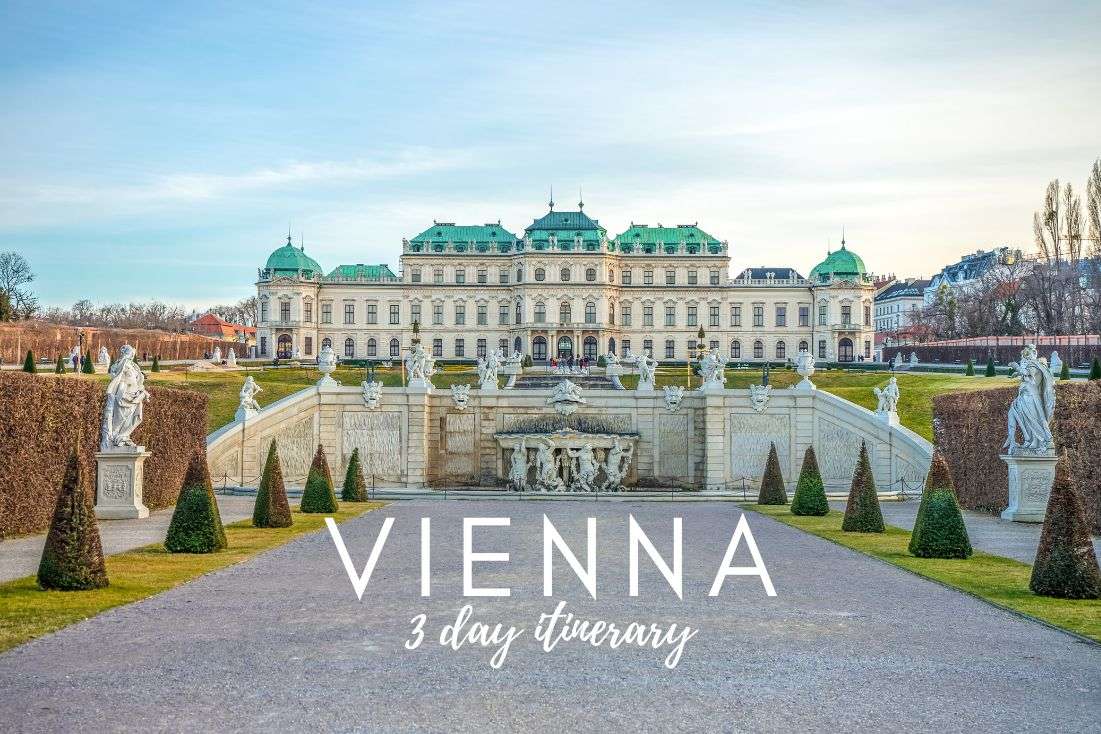
Vienna and I are lifelong frenemies—she’s gorgeous, a little uptight, and knows it. But if you’re planning a Vienna city break, you may just fall hard—no judgement. I’m the first to admit Vienna was a little too boring for me at first, but she grew on me. Eventually.
Yes, three days in Vienna is enough: my 3-day itinerary only includes all the places that left the best lasting memories: the imperial must-visits, the best cafés for original Sachertorte, and a few unusual stops too (eco‑quirky Hundertwasser and even sharks in a WWII flak tower).
This is an itinerary you can easily get around using your own two feet and a tram here and there. It looks something like this:
Quick itinerary overview for your three days in Vienna:
Day 1:
- Stephansdom
- Anker Clock
- Cafe Sacher for the famous sacher torte
- Belvedere
- Karlskirche
- Mariahilfer Strasse
- Rathausplatz
- Hundertwasser House
- Kunst Haus Wien
Day 2:
- Schönbrunn Palace and Gardens
- Palm House
- Schönbrunn Zoo
- Haus des Meeres
- Imperial Treasury
Day 3:
- Museum Quartier & mumok
- Kunsthistorisches Museum Vienna (Museum of Art History)
- Hofburg Palace and Heldenplatz
- Albertina
- Prater Giant Ferris Wheel
You’ll get:
- Turn‑by‑turn Google Map and realistic walking distances
- Up‑to‑date opening hours and 2025 ticket prices
- My unfiltered experience and opinions—because Vienna’s not perfect and you deserve more than generic brochure text
Ready? Grab a melange and let’s conquer 3 unforgettable days in Vienna.

Sometimes, all you need to do is take the first step... I've filtered out the best hotels in Vienna for you
Save it for yourself to come back to later, or share with your friends on social media!
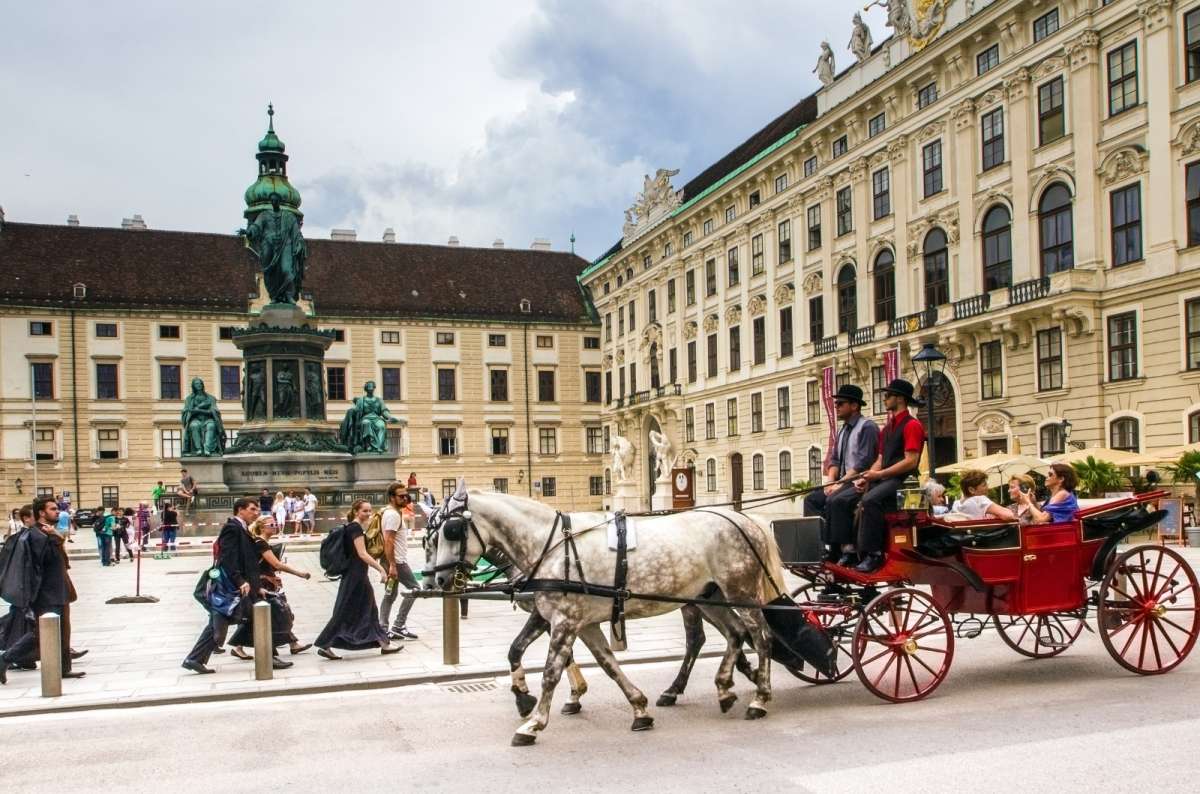
Some people like to take a royal ride through Vienna’s majestic Hofburg Palace square (not me, I’m allergic to horses)

Sipping coffee with a view 9(just around the corner from Stephansdom)
Is Vienna worth visiting?
Vienna is worth it if only to prove me wrong. Heck, even I plan on visiting Vienna for 3 days soon, because I’m starting to feel like I want to give it another chance to redeem itself. Second (and third and fourth) chances, you know?
Austria’s capital isn’t exactly my favorite place in the world, because frankly, it felt a little boring to me. It’s not that there’s anything especially bad about it, it’s more that there’s nothing that spectacular about it when compared to other European metropolises. But it’s clean and well-connected logistically, so that’s bonus points!
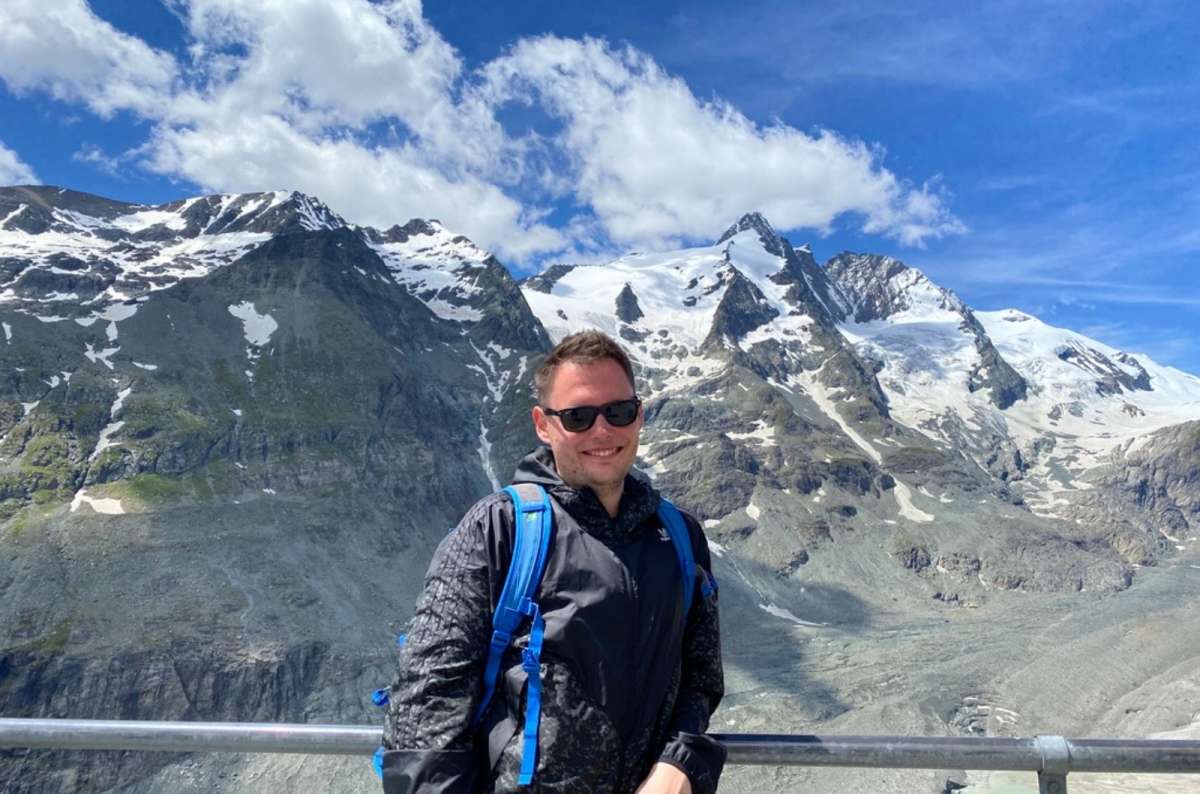
Nature’s more my vibe anyway—and Austria totally nails it! 3 days in Vienna and then I’m ready to move on

Where should I stay for a Vienna city break?
First‑timers who want to walk everywhere should base themselves in Innere Stadt (1st District)—the historic center. Nightlife and boutique‑shop fans favour Neubau (7th) around MuseumsQuartier; and luxury seekers head to Landstraße (3rd) for palace‑style digs.
For a tested (by me), no‑regrets stay, book one of these two hotels:
-
Steigenberger Hotel Herrenhof—four‑star comfort in Innere Stadt, 3 minutes from Hofburg; perfect if you want to step out the door into history.
-
Boutiquehotel Das Tyrol—art‑packed boutique gem in Neubau, literally on the edge of MuseumsQuartier and a tram stop from everything else.
Day 1 of 3-day Vienna Itinerary: Cathedrals, Coffee & Hundertwasser
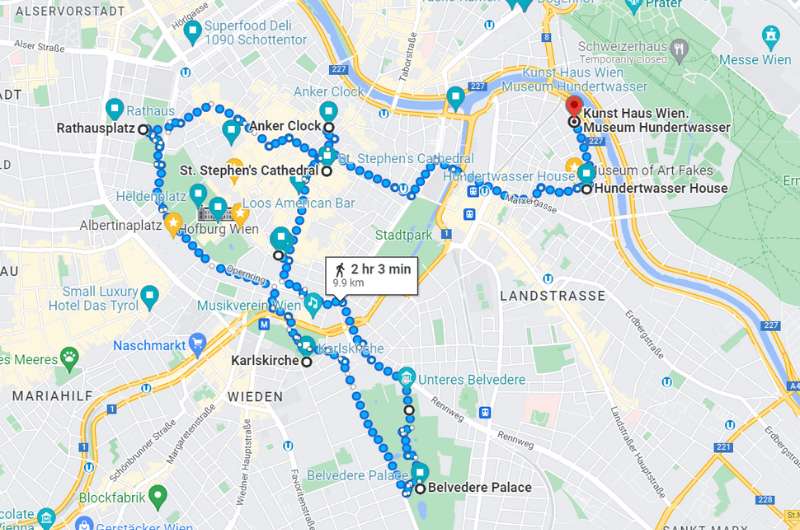
You can see the route with all the stops of the day on Google Maps
Main sites visited on day 1: Stephansdom, Anker Clock, Cafe Sacher, Belvedere, Karlskirche, Mariahilfer Strasse, Rathausplatz, Hundertwasser House, Kunst Haus Wien
Restaurant tips: KLYO | Superfood Deli | Taeko Ramen
Hotel recommendations: Boutiquehotel Das Tyrol | Steigenberger Hotel Herrenhof
Further reading: Austria itinerary | Know Before You Go: Austria
Day 1, stop 1: Stephansdom
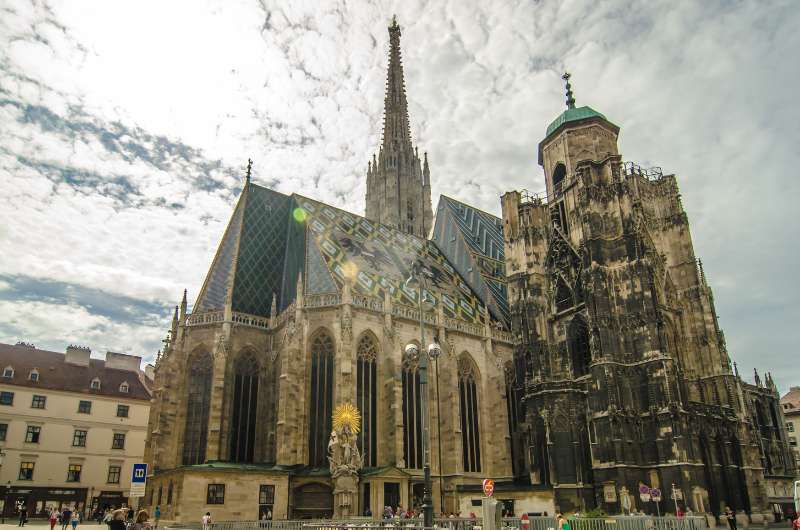
St. Stephen’s Cathedral, finally, after years of being covered in scaffolding, it’s naked again!
Time spent here: 1 hour (or less if not seeing all of it)
Opening hours & tickets
-
Open Mon–Sat 09:00–11:30 & 13:00–16:30 | Sun/hol 13:00–16:30
-
Free nave glimpse; EUR 7 basic entry at busy times | EUR 5 to climb the south tower
-
All-inclusive pass EUR 25 (cathedral interior + audio guide + South tower + North tower lift + catacombs + Dom Museum)
It’s Day 1 on your Vienna in 3 days itinerary, and your first stop is the mandatory St. Stephen's Cathedral. This church stands prominently on Stephansplatz—even a bit too prominently, because it takes up the whole square! You’d think they’d give it a bit more breathing room, sheesh.
Anyway, Stephansdom is famous not just for its size, location in the very center of Vienna, and cool roof design, but also for its almost constant restoration works—it’s a centuries-long work in progress. Since its first completion in 1160, there’s always been work being done on it.
Nowadays, the scaffolding on the south tower is finally gone, the heating system is finished… and that half-hidden mural they unearthed in 2020 is still on display beside the gift shop door (how dusty was it??).
Tickets to Stephansdom and what’s included
You can peek down the main nave for free most days, but I’ve seen reports that at peak times, a steward may prod you for a quick EUR 7 basic ticket. Anything deeper—the catacombs, south-tower climb, treasury, or a proper look at the altar—requires the all-inclusive EUR 25 pass, which now comes with a smartphone audio guide. Remember, this is a working church, so access may be restricted if something extra-churchy is going on inside.
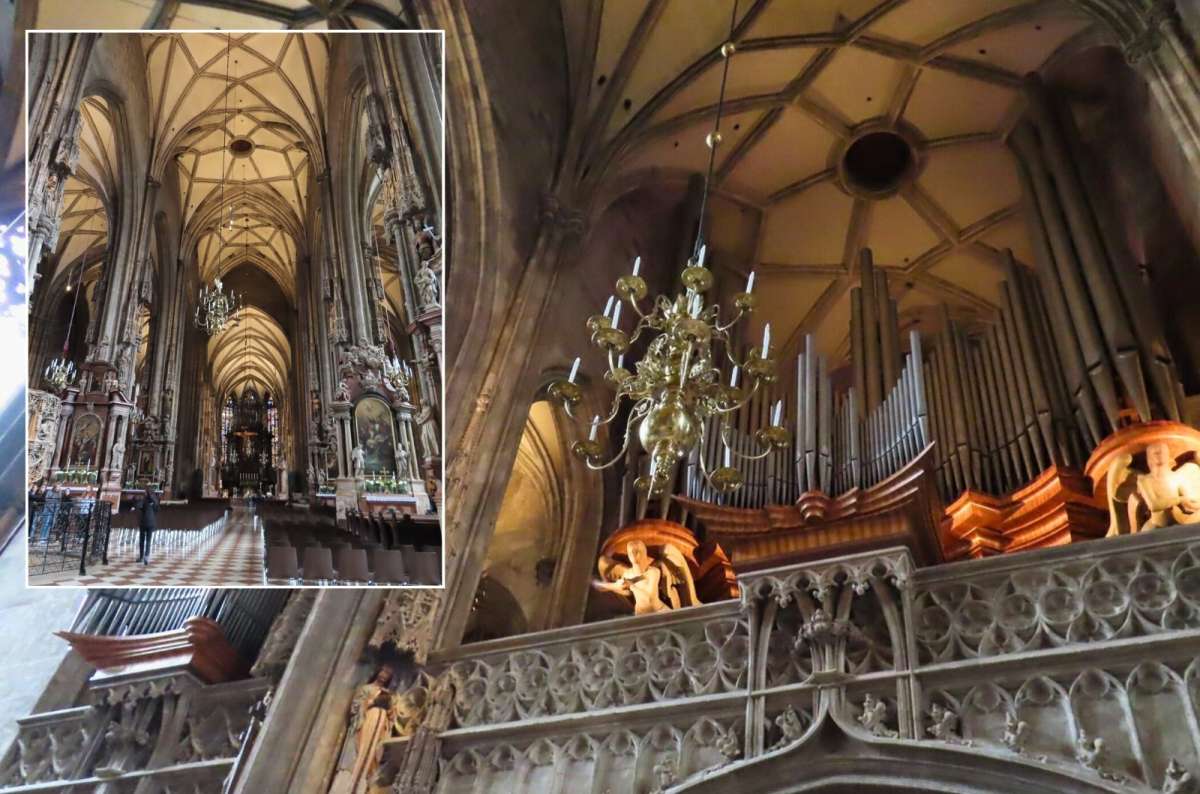
Gothic grandeur and heavenly harmonies @ Stephansdom
Also included on the all-inclusive ticket:
-
Climbing the winding staircase of the south tower to get cool views of the city, the tiled roof, and the rich people’s apartments.
-
Taking an elevator up the north tower for the best views of those tiles that are so inconveniently on the rooftop, and also Vienna’s largest bell, the Pummerin.
-
Wandering around the catacombs (only with a tour guide), where you’ll be in the company of the bones of 11,000 people, including some very high-ranking Habsburgs (actually, Stephansdom only has their internal organs, but more about that on the tour).
If you want to see everything, set aside 1.5 hours. Otherwise, it really depends on which parts you want to see. The catacombs tour takes 30–45 minutes, depending on how big your group is and how many people speak English vs German (they translate everything into both languages if needed).
What’s not included right now: the Stephansdom Treasury remains closed for long-term renovation with no reopening date set, so it’s not part of the ticket.
Tickets are still on-site only—no online sales—so hit the desk with real money in hand, then follow the yellow “Audio Guide” stickers to grab the QR code for the narration.
Day 1, stop 2: Ankeruhr (Anchor Clock)
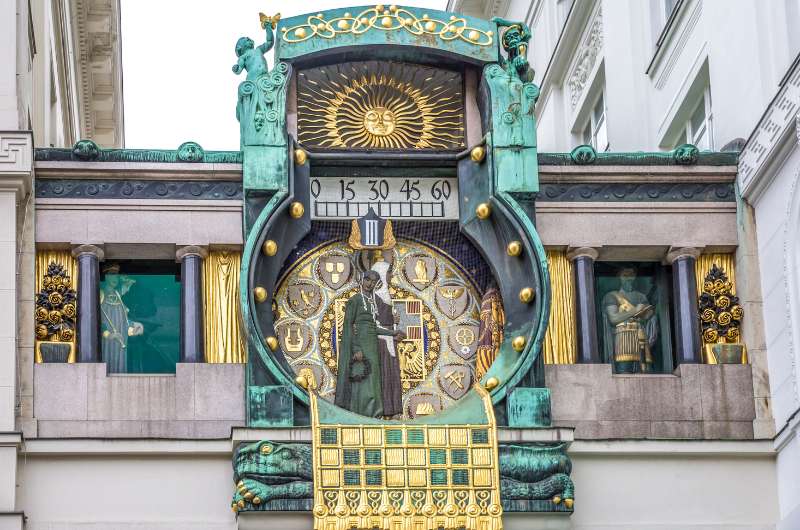
The Anker Clock
Distance from last stop: 300 m (0.2 miles)/4 minutes
Time spent here: 10 minutes
Now take a little quick stroll through the streets off of Stephansplatz. A couple of blocks north is the Anker Clock, built in Art Nouveau design in 1914.
It forms a bridge between two buildings, with 12 figures “walking” through the little windows, each being showcased for 1 hour and accompanied by music on the hour every hour.
The main attraction is at noon when all 12 figures form a parade for all of the tourists on the street below. It takes about 10 minutes, so prepare for your neck to ache afterwards!
Tip: During Advent, there are Christmas carols being played by the clock at 5 pm and 6 pm daily.
There’s a plaque next to the clock that shows the names of the figures for each hour, so you can Google who they are when you see them to make more sense of the spectacle. There are composers, singers, emperors, and some other people who are somehow important in Viennese history.
Day 1, stop 3: Time for Sacher!
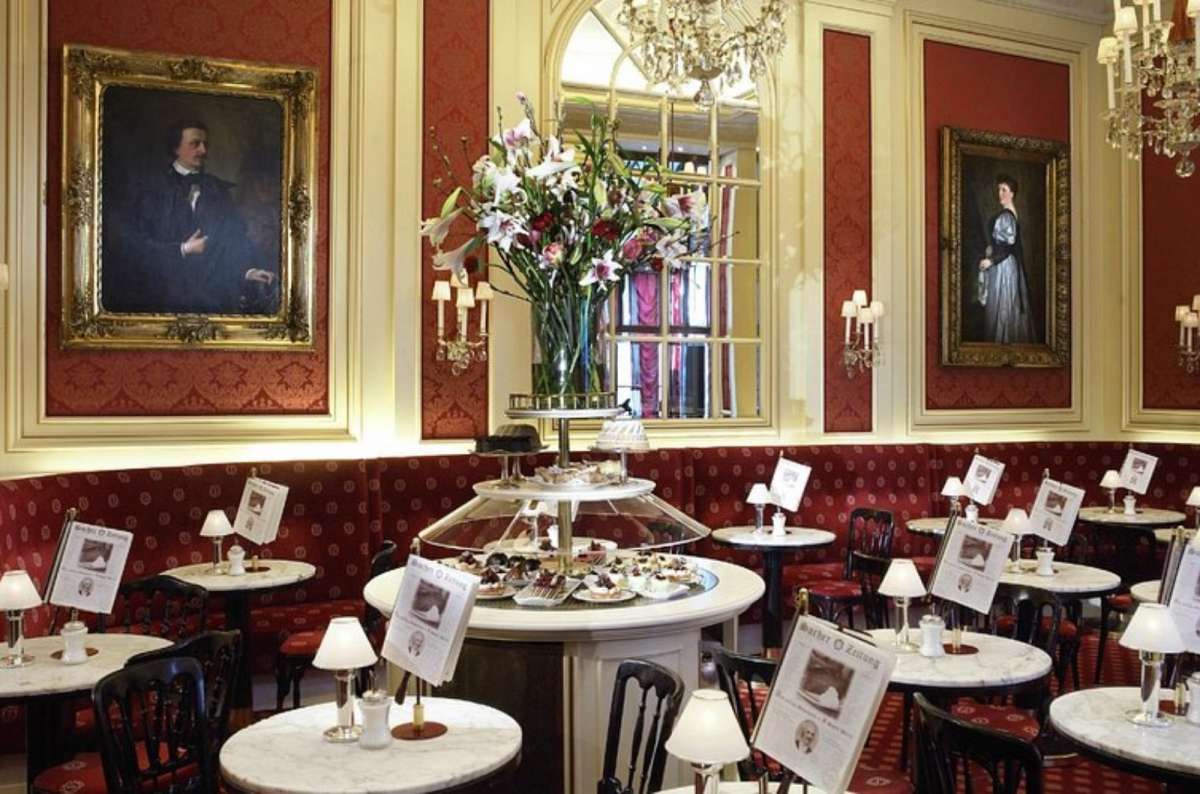
Living the sweet life at Café Sacher in Vienna
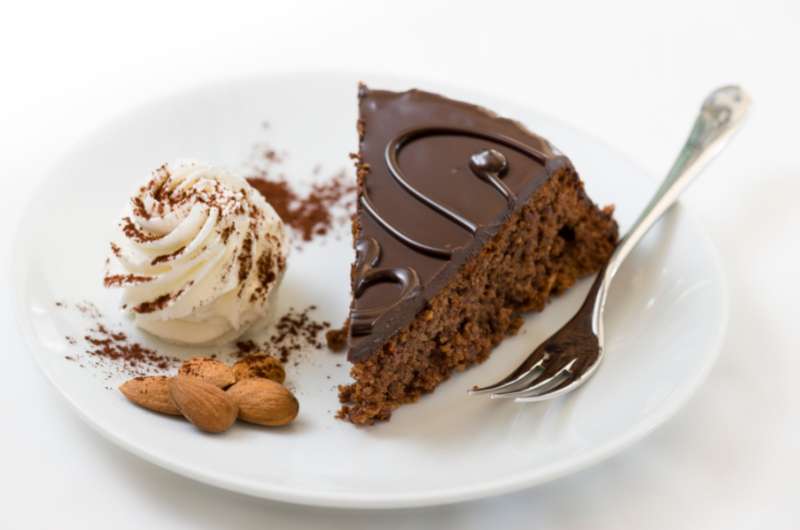
Distance from last stop: 1 km (0.6 miles)/12 minutes
Time spent here: 1 hour
Opening hours for Café Sacher Vienna
- Open daily 7 am–11 pm
Is it ever too early for cake? Nah, and this one is a Viennese classic—Sachertorte is a decadent chocolate cake with apricot jam in the middle. So let’s get some of that goodness into your system before continuing on to the next stop in this Vienna itinerary.
The home of Sachertorte is Café Sacher, a café with a typical Viennese coffeehouse atmosphere. It’s part of Hotel Sacher Wien, which is a fabulous, very Viennese and very expensive 5-star hotel in the center of Vienna.
You can walk to Hotel Sacher Wien from Stephansplatz in about 10 minutes using the pedestrian street called Kärntner Straße.
Café Sacher offers Sacher from an original 1832 recipe, so go and try the famous cake at its original home. It sits across from the State Opera, so you can get a glimpse of that on the way, too.
New for 2025: You can now reserve a table on Café Sacher’s website up to 30 days ahead—flash the booking at the door and go straight in like a VIP. Given that waiting times can easily be 30 minutes+, a reservation is a must.
If you can’t get in, there’s always plan B: head just a few steps down the block to the corner of the hotel to Sacher Eck (“Sacher Corner”). This two-story café is lavish and belongs under the Sacher Hotel as well, so no need to compromise on Sacher quality; it’s just a less famous place to eat at.
Day 1, stop 4: Belvedere
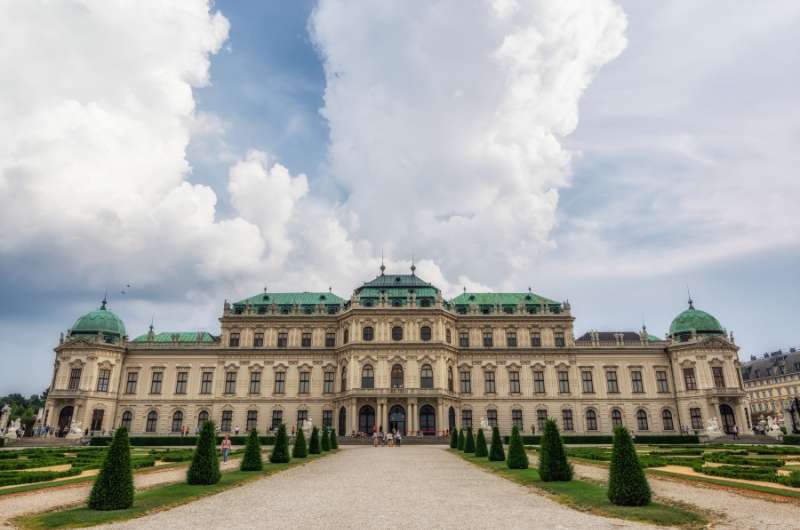
The South of Belvedere—The Upper Belvedere
Distance from last stop: 1.3 km (0.8 miles)/15 minutes to northern gate
Time spent here: 2 hours to see at least one museum, min. 4 hours for everything
Belvedere opening hours & tickets
- Upper Belvedere EUR 19.50 online (EUR 21 on-site)
- Lower Belvedere EUR 16.50.
- Klimt Day Ticket EUR 28.30 = Upper + Lower on the same day—cheapest way to see The Kiss and the temporary “Viva Venezia!” show.
- Free Smartify audio tour (download on your phone).
- Daily 10 am–6 pm. Book a 10:00 slot to enjoy “The Kiss” with fewer elbows.
Now it’s time to offset those Sacher calories and take a walk to the Belvedere palaces and gardens to see some art, history, and some perfectly-shaped bushes.
The Belvedere consists of the Upper Belvedere Palace (in the south), the Lower Belvedere Palace (in the north), and the 600 m (0.4 mile) long garden that’s between them, plus the Belvedere 21 art space.
It’s recommended to get your tickets online in advance to get in in your desired time slot for the palaces. You can then stay at the palace of your choice as long as you’d like.
Which one you visit really depends on where your interests lie. Expect to spend 1 hour in the Lower Palace and 2 hours in the Upper Palace, but that’s really just focusing on the main parts. If you wanted to see both palaces and the gardens properly, you’d need up to 5 hours.
To be honest, you don’t have that kind of time on this itinerary, so I suggest just choosing one of the museum/gallery spaces.
The Upper Belvedere
The Upper Belvedere is the main palace, bigger and grander, and houses a large Gustav Klimt collection, including his most famous work, “The Kiss”. Plus works by Schiele, Funke, Messerschmidt and van Gogh.
The Lower Belvedere

Prince Eugene’s palace
The Lower Belvedere and stables show special exhibitions and art from all periods. The palace is overall smaller and less grand, but still nice. It’s where Prince Eugene used to live, so it’s not ordinary in the slightest.
Belvedere 21
If you’re more into contemporary art or think palaces are boring, visit the Belvedere 21 instead. It belongs under the Belvedere umbrella, but it’s a “vibrant urban hub” just a bit further south from the Upper Palace. It is included in the 3-in-1 Belvedere ticket.
The gardens
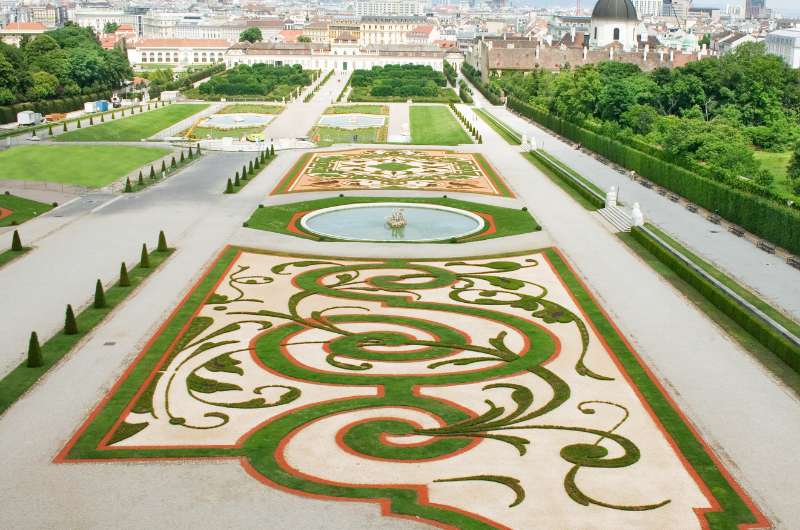
The gardens between the palaces are perfectly manicured, as you would expect in Austria. Everything is symmetrical, with fountains, statues, and flowers that know exactly how to stand, and bushes that look like they were cloned. Don’t forget to visit the lake in front of the Upper Belvedere! You might miss it if you’re coming from the city center.
The main garden is free to enter, as is the botanical garden. The Privy Garden is free if you have a palace ticket. Then there’s Europe’s oldest Alpine garden with over 100 bonsais and the main attraction—rhododendrons that blossom starting in April. You pay EUR 4 to see those (this garden is only open from the end of March to the beginning of August).
I love rhododendrons, so I’d certainly try to see the Alpine Garden if you’re visiting at a time when you can see the flowers in full bloom—it’s just spectacular.
Getting there
You can enter the Belvedere from the main gate in the south if you want to get to the Upper Belvedere asap, or through another gate in the north which is where you’ll be coming from (by the Lower Belvedere).
You can walk to the northern gate from Café Sacher in about 15 minutes or to the main gate in about half an hour (it’s 2.2 km/1.3 miles). You can also take tram D from Oper, Karlsplatz to Quartier Belvedere to save yourself the effort if that seems too far.
Day 1, stop 5: St. Charles Church (Karlskirche)
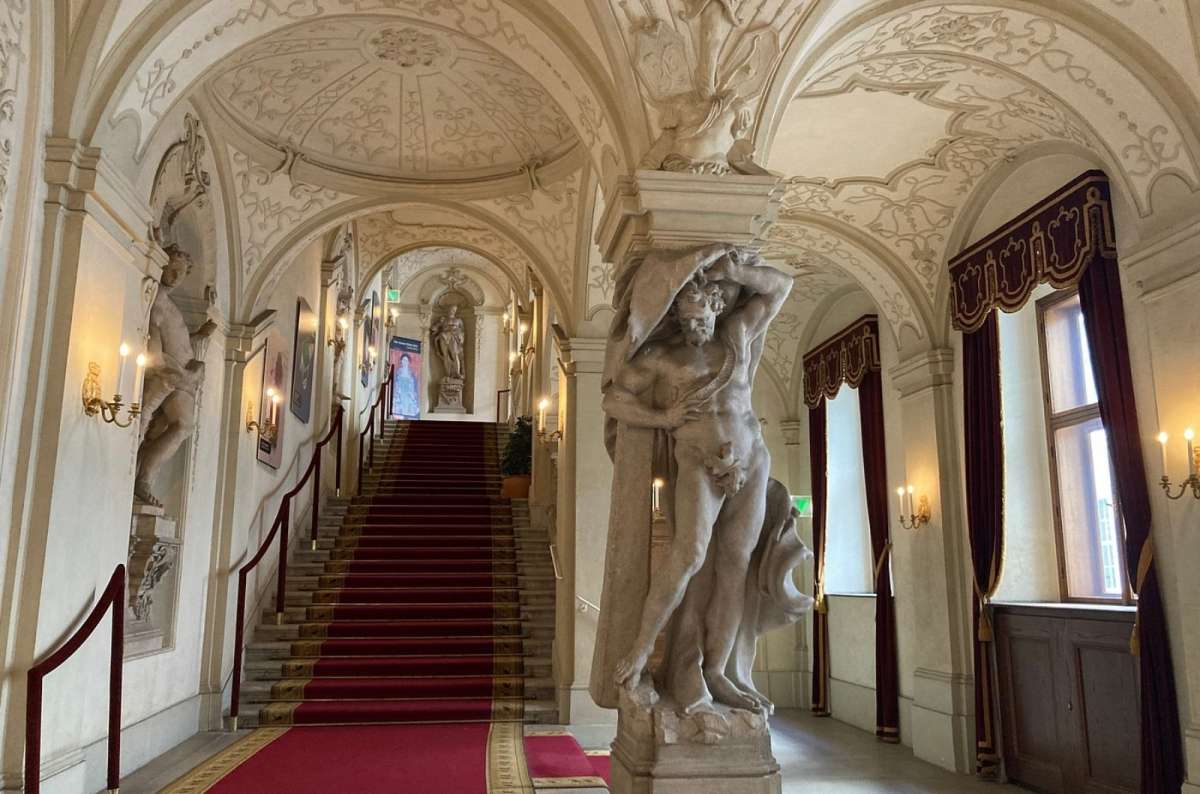
Fancy-pantsy staircase at Karlskirche (or actually, not very pantsy at all)
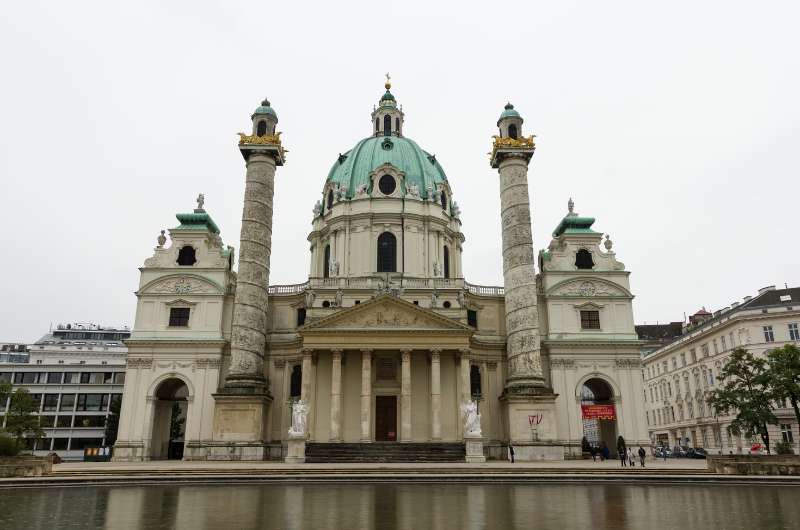
St. Charles Church
Distance from last stop: 800 m (0.5 miles)/10 minutes from Belvedere northern gate
Time spent here: 20 minutes
Karlskirche opening hours & tickets
- Adult ticket EUR 9.50 at the right-side kiosk; card accepted.
- Ticket includes elevator to the fresco walkway and the small treasury display.
- New Panoramic Terrace ticket lets you step outside the dome for EUR 2.
- Monday–Saturday: 9:00 am–6:00 pm
- Sunday & public holidays: 11:00 am–7:00 pm
- Last elevator ride to the fresco platform departs about 30 minutes before closing.
Just a 10-minute walk back towards Vienna’s historic center is the Karlskirche, aka St. Charles Church. It’s hands-down the best Baroque church in Vienna, but is actually a mix of styles: Byzantine, Renaissance, and Baroque with Greek and Roman elements. You’ll see what I mean when you see the two huge columns in the front.
Construction of the church, dedicated to St. Charles Borromeo, began in 1716 as a sort of “thank god it’s over” token after the last great plague epidemic.
There’s a slightly out-of-place metal elevator in the middle of the church that takes you up to the dome so you can stare at the ceiling frescos from way up close. Personally, I prefer the neck‑crick view from the nave—I’m pretty sure that’s how the painters intended it. It does seem to bother some folks from what I’ve read, but to each their own; no fresco police will drag you onto the lift
You can also go outside on the terrace for a surprisingly decent view of the city and the fountain‑park combo in front.
If your heart and ears desire it, you can go to a classical music concert at Karlskirche as well.
Use the reviews on Google Maps for the most up-to-date visitor information. The church’s website has no information whatsoever unless you’re looking for mass times or are planning a wedding and speak German.
Day 1, stop 6 (optional): Mariahilfer Straße
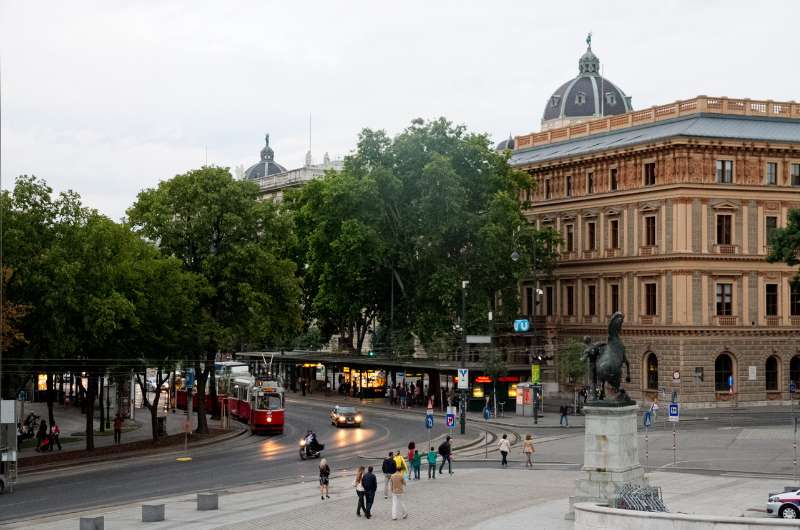
Mariahilfer Street in full motion
Distance from last stop: 1 km (0.6 miles)/12 minutes
Time spent here: 0 to infinity
Mariahilfer Strasse shopping tips 2025
-
Most stores are open Mon–Fri 09:00–19:00, Sat 09:00–18:00; almost all are closed Sunday by law.
-
New 2024/25 curb-to-curb bike lane means fewer delivery vans—but watch for the crazy e-scooters.
-
Pop-up “parklets” (mini terraces) between Kirchengasse and Zieglergasse offer free Wi-Fi and phone charging.
Mariahilfer Straße is Vienna’s longest shopping street (at about 1.8 km/1.1 miles) with endless chains, indie boutiques, caffeine pit‑stops, and plenty of hotels.
It’s conveniently close to Karlskirche in the general direction you need to be going, so it’s easy to take a look if you want to. It’s right behind the Kunsthistorisches Museum Wien, which you’ll be checking out on day 3 in Vienna.
You absolutely don’t have to (it’s not like you can’t shop at home), but if you wanted to skip some other stuff on this itinerary and ended up with extra time on your hands, you can easily waste it on Mariahilfer Straße.
The street is largely pedestrianized, though local traffic and buses are allowed in, so you're mostly the king of the road—but watch for the occasional bus that didn’t get the memo.

Design elements galore @ Boutiquehotel Das Tyrol
My hotel tip: The 4-star Boutiquehotel Das Tyrol is full of art—pieces from Vienna’s best designers decorate the interior. It’s located on Mariahilfer Straße shopping street, just a short walk from a metro station.
The beds in this hotel are uber-comfortable, the staff goes above and beyond and Prosseco is served with breakfast.
Day 1, stop 7: Rathausplatz and Town Hall
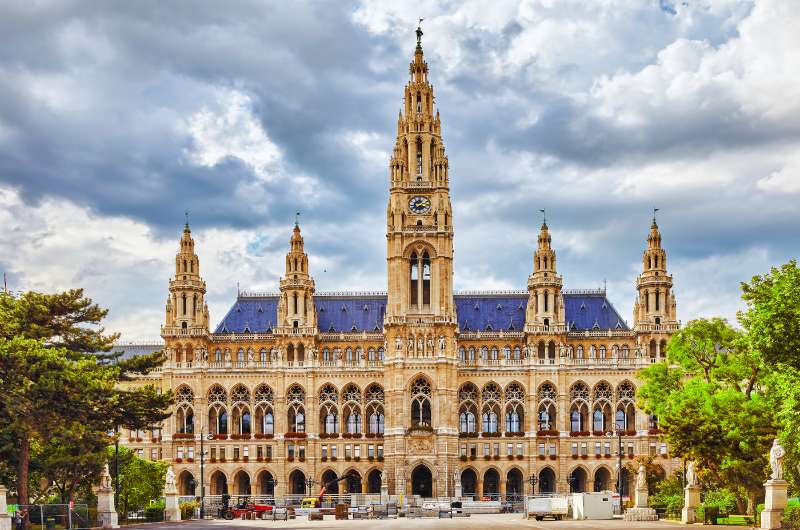
Rathausplatz Townhall
Distance from last stop: 2 km (1.2 miles)/5-minute tram ride/25-minute walk
Time spent here: 20 minutes
Rathausplatz events calendar 2025
- Film & Food Festival: 4 July–31 Aug 2025, every night at dusk, free entry, street-food village from 11:00.
- Christkindlmarkt: mid-Nov to 26 Dec, then the square turns into an epic ice rink (Wiener Eistraum) until late Feb 2026.
- Pro tip: Arrive at the U2 “Rathaus” to dodge tram diversions during summer setup.
Hop a tram at Oper/Karlsplatz (or Burgring if you detoured to Mariahilfer) and ride four stops to Rathausplatz—window‑gazing the Opera, Kunsthistorisches, Hofburg, and Parliament on the way.
Rathausplatz is event HQ: Vienna’s biggest Christkindlmarkt and ice‑path rink in winter, film‑and‑food fest in summer. Even a tough guy like me calls it magical. The Rathaus façade was inspired by Brussels’ Town Hall (check out my Brussels guide to see what I mean), the crown jewel of the Grand Place. The interior tour is mostly offices; I stick to the façade photos.
If no festivals’s on, five minutes is plenty to soak it in before moving on.
Day 1, stop 8+9: Hundertwasser House and Kunst Haus Wien
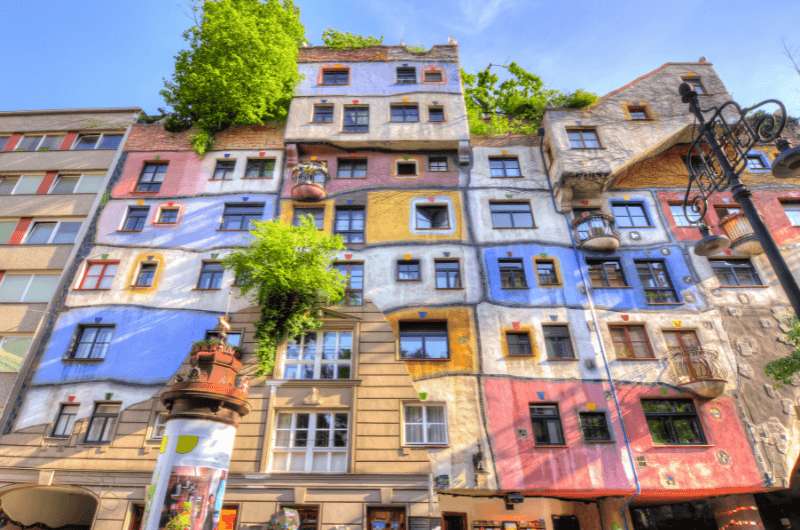
Hundertwasser House
Start at the Hundertwasser House
Distance from last stop: 3 km (2 miles)/15 minutes by tram/40-minute walk
Time spent here: 10 minutes
Kunst Haus Wien opening hours, ticket prices & location
-
Hundertwasser House is on Kegelgasse 37–39
-
Residential facade—viewing is still free 24/7; the ground-floor Hundertwasser Village souvenir arcade opens 9 am to 6 pm daily.
-
Kunst Haus Wien—Hundertwasser Museum (2025 update): Open 10:00 am—6:00 pm daily (last entry 5:30 pm). An EUR 12 combo ticket gets you the permanent Museum Hundertwasser plus the buzzy temporary show (Antimatter Factory runs until 10 Aug 2025). Find it at Untere Weißgerberstraße 13
Once you’ve soaked up enough Rathausplatz ambience, hop back on tram 1 to Hertzgasse—time for some full-blast colour therapy. Hundertwasser House looks like you let kindergarten kids loose on an apartment block, yet it’s an architectural highlight (built 1983–1985) designed by painter-turned-eco-visionary Friedensreich Hundertwasser. Expect bold colours, swirling lines and trees sprouting from balconies.
The building is still residential, so it’s view-only from the outside, but do invest EUR 2 in the new AR brochure at the info booth: point your phone and watch the façade “grow” greenery in real time.
Done counting roof-trees? Stroll three short blocks to its sibling.
Tip: The Fälschermuseum, or Museum of Art Fakes, is directly across from the Hundertwasser House. This “criminal” art museum is unique in Europe and probably worldwide. It is filled with faked paintings and mystery stories. Get details in my article on Unusual Things to Do in Vienna.
Next stop: Kunst Haus Wien
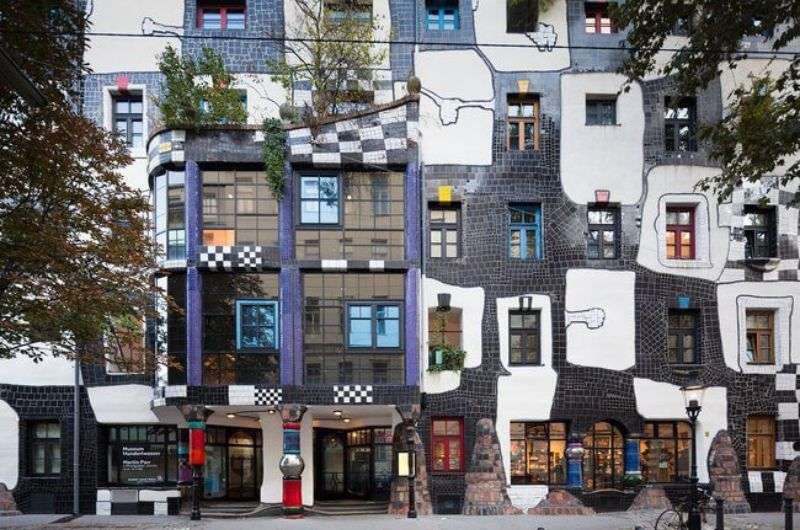
Kunst Haus Wien
Distance from last stop: 450 m (0.3 miles)/5 minutes from Hundertwasser House
Time spent here: 1 hour
Kunst Haus Opening hours & tickets
- Daily 10:00 am–6:00 pm (last entry 5:30 pm)
- EUR 12 combo = Museum Hundertwasser + current exhibition (“Antimatter Factory” until 10 Aug 2025), EUR 11 Museum only, EUR 9 exhibition only
- Located on Untere Weißgerberstraße 13
For a deeper dive into Hundertwasser’s psyche, step inside Kunst Haus Wien—same riot of colour, but this time clad in tiled mosaics and wavy floors. The first two levels house the permanent Hundertwasser Museum, while the upper galleries rotate photo-heavy shows (right now it’s “Antimatter Factory,” a surreal look at global supply chains).
Don’t rush past the building itself: every uneven stair and leafy corner shouts the artist’s eco-utopian mantra. After you’ve OD’d on colour, decompress in the plant-filled café or hunt for swirly-roof mugs in the shop.
Day 2 of 3-day Vienna Itinerary: Schönbrunn Palace, Pandas & Crown Jewels
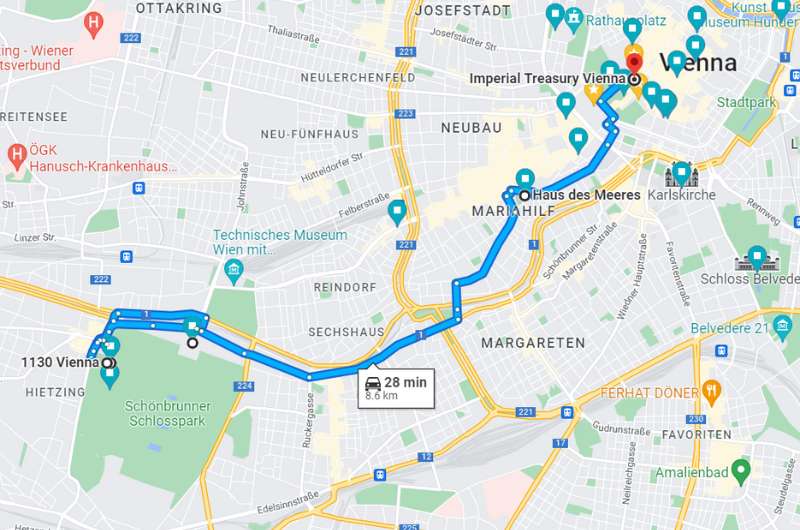
You can see the route with all the stops of the day on Google Maps
Main sites visited on day 2: Schönbrunn Palace and Gardens, Palm House, Schönbrunn Zoo, Haus des Meeres, Imperial Treasury
Restaurant tips: KLYO | Superfood Deli | Dogenhof | Taeko Ramen
Hotel recommendations: Boutiquehotel Das Tyrol | Steigenberger Hotel Herrenhof
Further reading: Unusual Places in Vienna
Day 2, stop 1: Schönbrunn Palace and Gardens
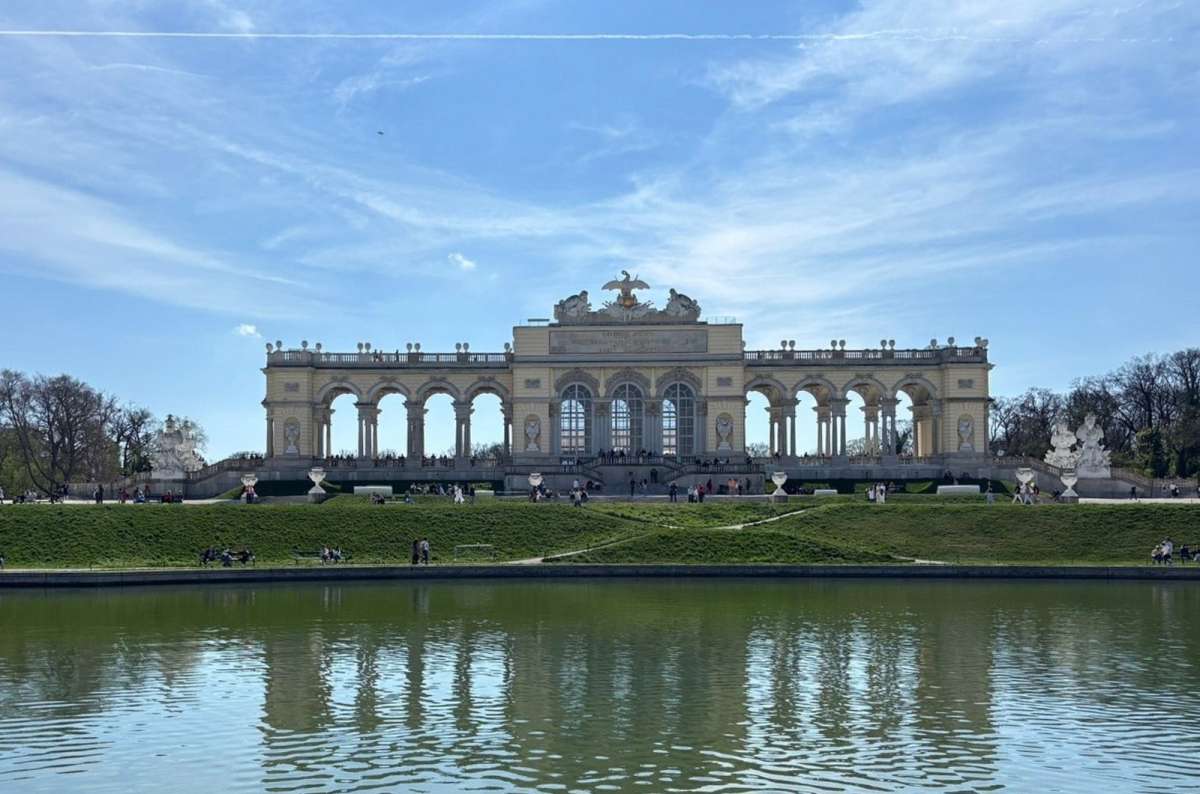
Postcard-perfect moments at the Gloriette
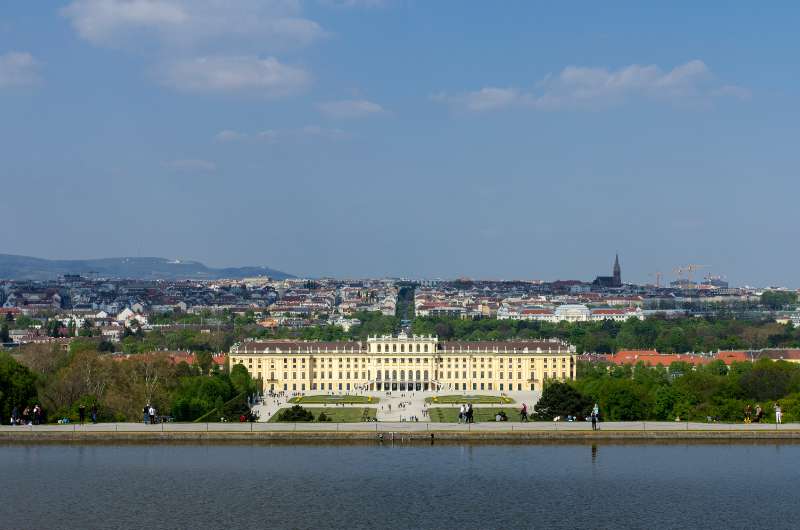
Schönbrunn Palace—the Austrian Versailles
Time spent here: 2 hours minimum, but you can spend all day here
Schönbrunn opening hours & tickets
- Palace opening hours: 8:30 am–5:30 pm year-round (winter close 5:00 pm—check website).
- Gardens: 6:30 am–8:00 pm (shorter in winter).
- Imperial Tour (22 rooms): EUR 27
- Grand Tour (40 rooms): EUR 34
- Classic Pass (palace + Gloriette + maze + Crown Prince Garden): EUR 31
- Sisi Ticket Deluxe (Schönbrunn + Hofburg silver collection): EUR 51
- Parking: EUR 4/hour.
- Website: schoenbrunn.at—book tickets early, especially June-Aug.
Schönbrunn Palace is an imperial summer residence in Baroque style, kind of like the Austrian version of Versailles.
It’s located a bit of a way away from the city center, but you can easily get there by tram, bus, or metro (Schloss Schönbrunn is the stop you’re looking for), and obviously by taxi too. If you have your own car, there is a parking lot ready to babysit your vehicle for EUR 4 per hour.
Right up front: the park is massive. If you try to see every fountain, maze, fake ruin and squirrel, you’ll burn a whole day. This itinerary cherry-picks the palace highlights, then saves you for the next two stops that also hide inside the grounds.
Pro tip: the next two stops—the Palm House and Schönbrunn Zoo—are inside the same park, so keep your day-ticket handy and wear shoes that forgive cobblestones.
Tours at Schönbrunn Palace
I’ve sampled the menu so you don’t have to gamble: the Imperial Tour (22 rooms, audio guide, 30 ish minutes) is a decent palate cleanser—but half the chambers are filler, and just when the good stucco starts, you’re back in the gift shop. Go Imperial only if you’re short on time or patience.
Serious chandelier‑chasers should book the Grand Tour—40 rooms in about an hour. It’s still self‑guided, but you finally reach Maria Theresa’s peacock‑level salons and the enviable porcelain stove collection.
Schönbrunn sells a half‑dozen other combo tickets too, so poke the website first and, for the love of schnitzel, book ahead. I once turned up on a July afternoon and was quoted a three‑hour wait slot—plenty of time to memorise every statue in the gardens, but not ideal itinerary‑wise.
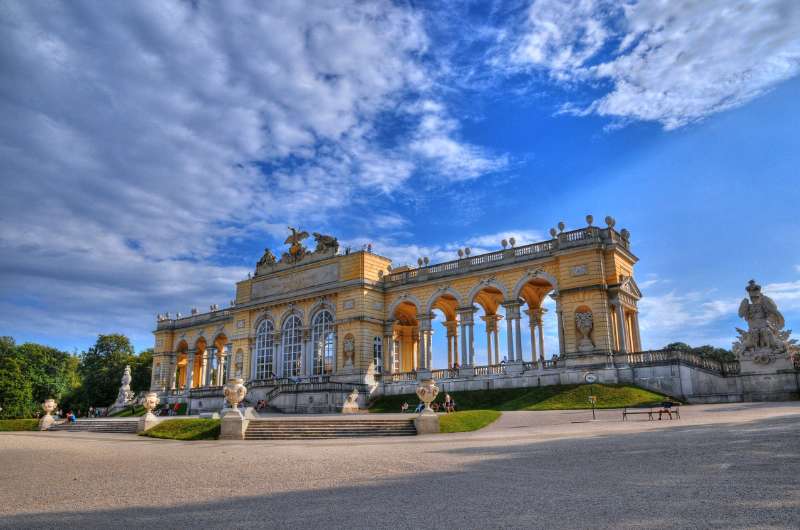
Gloriette Schloss—the best place to photograph the Schönbrunn Palace
Skipping the palace? No problem, it’s still worth visiting
I’ve done Schönbrunn without going inside Schönbrunn, and it still delivered. The gardens are colossal and easily hold their own: fountains, lakes, statues, fake Roman ruins, a rose maze, and endless tree‑lined avenues that make you forget the Ringstrasse traffic exists.
Entrance to the Schönbrunn gardens is free.
Gloriette Viewing Terrace—the free postcard shot
When you’re strolling the parkways (gardens open 6:30 am—8:00 pm, always free), hike up to the Gloriette Terrace for the money shot: palace, parterres and Vienna’s skyline in one frame. The climb is worth the calf burn, and the viewpoint costs exactly EUR 0.
Then, it’s not time to leave yet! There’s way more to see at Schönbrunn. See next items.
Day 2, stop 2: Palm House Schönbrunn
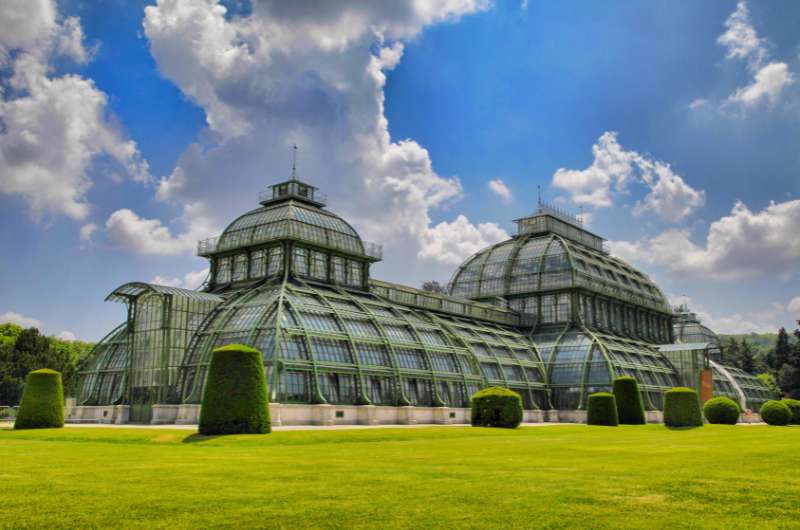
Palm House Schönbrunn
Distance from last stop: 0
Time spent here: 30 minutes
Palm House Schönbrunn opening hours & tickets
- Open daily 10 am–6 pm (5 pm in the winter)
- Tickets cost EUR 9, a combination ticket with the zoo is EUR 31.50
The Palm House is one of the many buildings/areas in the Schönbrunn gardens. It’s a big greenhouse that consists of three buildings: the warm house, the temperate house, and the cold house, each home to a special set of flora.
The imperial family, headed by Franz Joseph, wanted it built to showcase the “green treasures” of the empire. It was almost destroyed during the world wars and has had lots of work done over the past century and a half.
When the Palm House opened in 1882, it was the biggest greenhouse in the world. These days, it still belongs to the biggest buildings of this type in Europe.
You can go and enjoy the atmosphere. It’s not a long stop, maybe worth 30 minutes or so, but a nice addition to your Schönbrunn morning. There are benches in the Palm House where you can sit and relax if you’re starting to feel your legs.
Day 2, stop 3: Schönbrunn Zoo
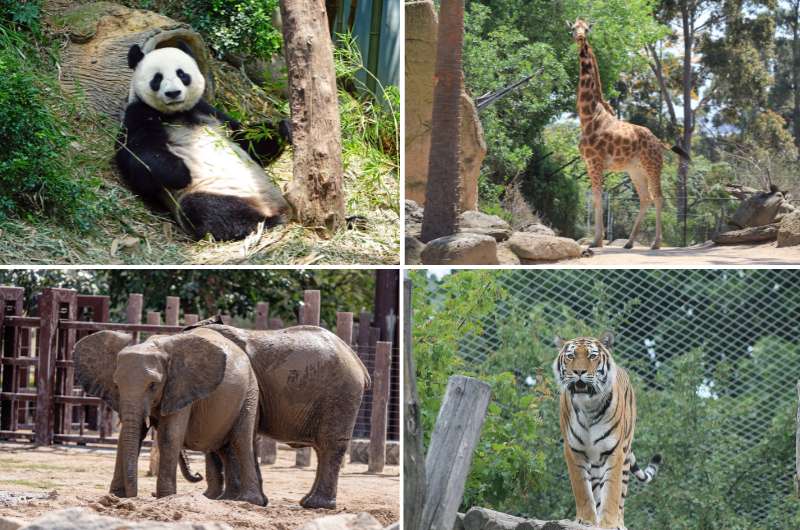
Distance from last stop: 0
Time spent here: 2 hours
Schönbrunn Zoo opening hours & tickets
- Open daily from 9 am, closes between 4:30 pm and 6:30 pm depending on the season.
- Tickets cost EUR 27 for adults, EUR 15.50 for kids over 6
Note: I included the zoo and the aquarium on this itinerary, which might be a bit much unless you are really into animals or have kids in tow. So I recommend choosing one or the other. You’ll still have a very full itinerary for the day.
Compared to other European Zoos, Schönbrunn Zoo is rather small, but on the other hand, there are giant pandas.
Apart from these cute, fluffy bears that like to fall over themselves, there are the obligatory elephants, giraffes, tigers, polar bears, and 500 other animal species waiting to be stared at.
There are paths in the zoo that are easy to follow thanks to the signage in both German and English. You’ll find plenty of places to sit and eat, though during lunchtime in the summer, it looked like it could be made into a “hungry humans in the wild” exposition. Good luck finding a table!
My personal favorite are obviously the giant pandas, who are just the goofiest animals on the planet. If you’re lucky, you’ll see them rolling around on their backs, holding their own feet, without a care in the world.
Day 2, stop 4: Haus des Meeres—the WWII Flak-Tower Aquarium
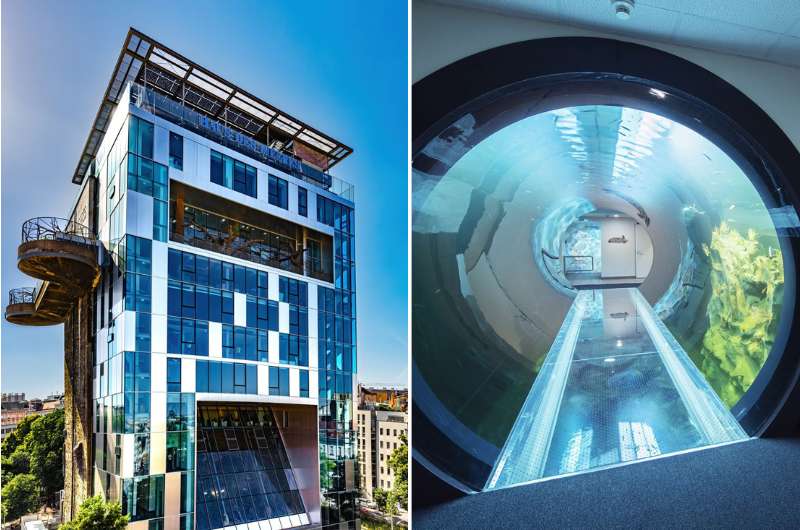
Visit the cool building of Haus des Meeres
Distance from last stop: 7 km/4.4 miles
Time spent here: 1.5 hours
Haus des Meeres opening hours & tickets
- Open daily 9 am–8 pm (Thursdays to 9:00 pm)
- Tickets cost EUR 23.90 for adults, EUR 10.90 for children over 6, EUR 7.90 for children over 3
It’s time to head back into the city. About ¾ of the way—close to our recommended Boutiquehotel Das Tyrol—are some animals you wouldn’t have met at Schönbrunn Zoo. Stop by Haus des Meeres (“house of the sea”) to see 10,000 creatures, mostly of the sea type, but also several monkey species, lizards, snakes, and insects. Does anybody ever really want to see the bugs?!
The museum is located in a former anti-aircraft tower from World War II. What used to be a tall concrete slab is now a multi-story piece of modern architecture with plenty of windows. It’s also unique to visit an aquarium where the inhabitants live on multiple above-ground floors. The hammerhead won top spot and is located on the 10th floor. I wonder if they even enjoy the views.
You’ll want to stop by 360° OCEANSKY Restaurant Bar for some views of your own, all while digging into some surprisingly good food, perhaps even with a cocktail. The rooftop restaurant and terrace are way cooler than anything you’d expect as part of a zoo.
Feeding tip 2025:
-
Shark feedings: Mon, Wed, Fri at 10:30 am—sharks are the highlight of this place, so if you want to see them move quicker than their usual steady pace, come during feeding time.
-
Piranha frenzy: Thu 3:00 pm—just once a week… apparently they’re on a diet.
Day 2, stop 5: Imperial Treasury Vienna (Kaiserliche Schatzkammer)
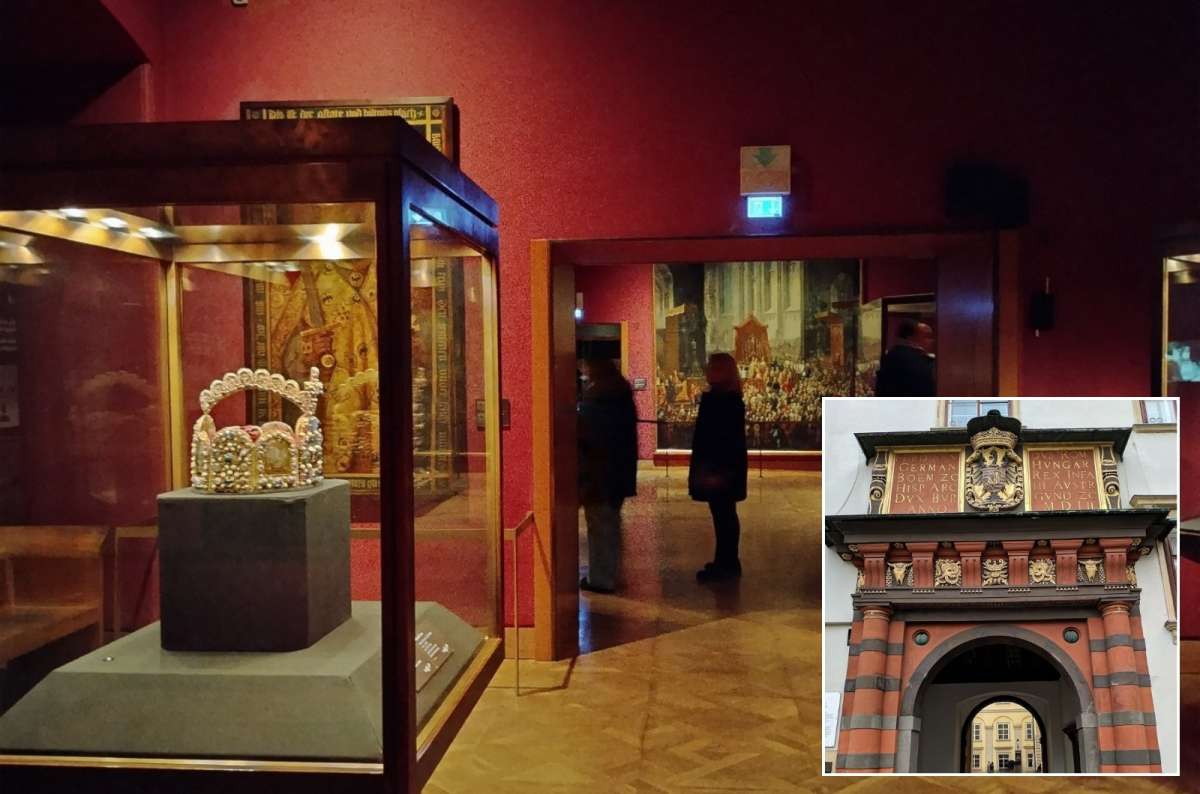
Visiting Vienna’s Imperial Treasury
Distance from last stop: 1.6 km (1 mile)/20-minute walk
Time spent here: 1 hour
Imperial Treasury opening hours & tickets
- Open daily except Tuesdays, 9 am–5:30 pm
- Tickets cost EUR 18 (book online to save EUR 2 and skip the ticket line)
- Audio guide is EUR 5 extra
To end the day on a more classically Viennese note than staring at some very out-of-place sharks, visit the jewels of the Roman Empire, including the Imperial Crown, at the Imperial Treasury.
Located in Vienna’s city center, the Imperial Treasury is part of Hofburg Palace, which you’ll see a little bit more of tomorrow.
You’ll get a real feel for the Habsburgs' wealth when you’re staring at all the incredibly intricate and over-the-top fancy treasures! Though I honestly wouldn’t want to be the baby in that creepy-looking crib!
Aside from all the real-world treasures in the Secular Treasury, you can also visit the Ecclesiastical Treasury for some religious artifacts and art.
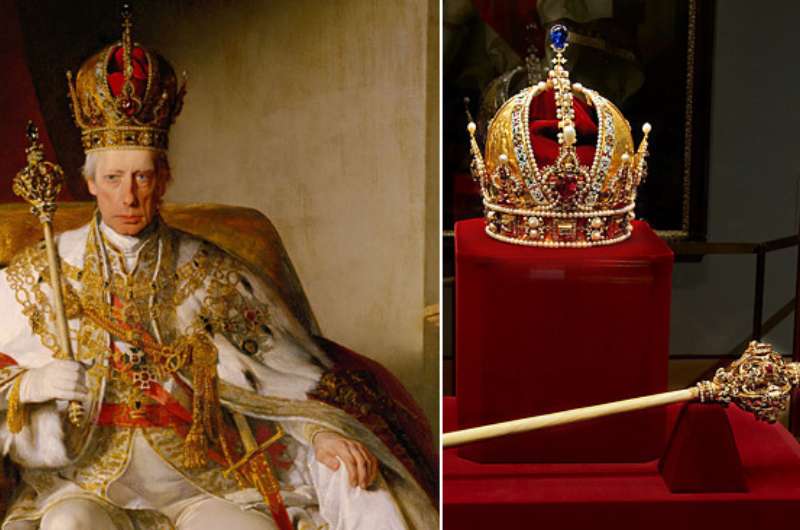
Kaiserliche Schatzkammer is the last stop on day 2 of your Vienna itinerary
You can either go in on your own with just your own eyeballs and knowledge, in which case I recommend reading a little about Vienna’s history, or get an audio guide that’ll assist your eyeballs in knowing what they’re seeing without your brain having to do much at all.
Day 3 of 3-day Vienna Itinerary: Museum Quarter, Hofburg & the Prater Wheel

You can see the route with all the stops of the day on Google Maps
Main sites visited on day 3: Museum Quartier, mumok - Museum moderner Kunst Stiftung Ludwig Wien, Kunsthistorisches Museum Vienna (Museum of Art History), Hofburg Palace and Heldenplatz, Albertina, Prater Giant Ferris Wheel
Restaurant tips: KLYO | Superfood Deli | Dogenhof | Taeko Ramen
Hotel recommendations: Boutiquehotel Das Tyrol | Steigenberger Hotel Herrenhof
Further reading: 7 Top Tourist Cities in Austria
Day 3, stop 1: Museum Quartier
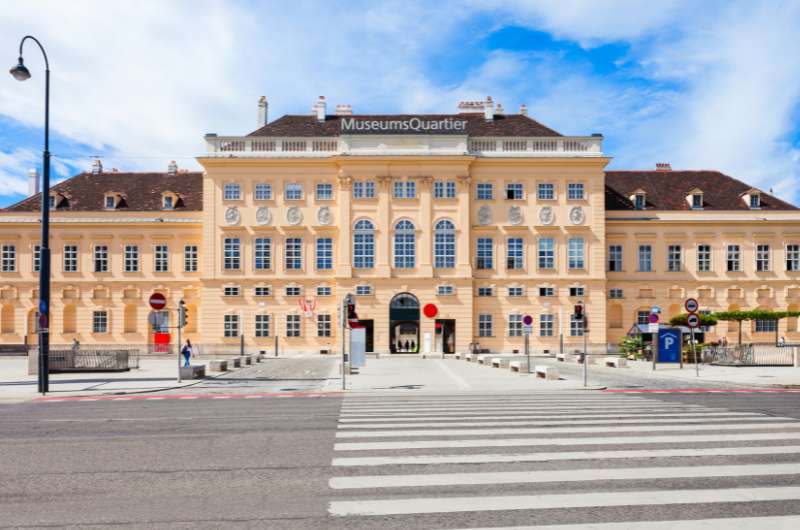
Museum Quartier
Time spent here: 30 minutes (without a coffee stop and without visiting the museums)
The very first stop on day 3 in Vienna drops you into the MuseumsQuartier—Vienna’s arts playground where Habsburg facades butt‑heads with Lego‑block modern cubes and the art veers delightfully weird. The courtyard is always buzzing: people sprawling on the big plastic loungers, jazz students busking, someone installing a six‑metre neon squid—that sort of vibe. In summer, they even roll out free events, oddball installations, and a minigolf course that looks like it was designed by Dalí on Red Bull.
I like to amble, eyeball the outdoor pieces, then refuel with a flat white (or beer, no judgement) at one of the cafes sprinkled around the square; most museums hide an espresso bar of their own.
New for 2025: grab the glass lift on the east side of the Leopold Museum up to the MQ Libelle terrace (10:00 am–10:00 pm, closed Tues, free). Best bird’s‑eye snap of the district, and the rooftop bar Zur Libelle pours a respectable spritz until 9:30 pm.
Book‑nerd tip: duck into Buchhandlung Walther König—tiny shop, floor‑to‑ceiling art books, smells like paper heaven.
Most venues here specialise in modern and contemporary art; we’ll deep‑dive into one of the big guns at the very next stop.
Day 3, stop 2: mumok (Vienna’s Museum of Modern Art)
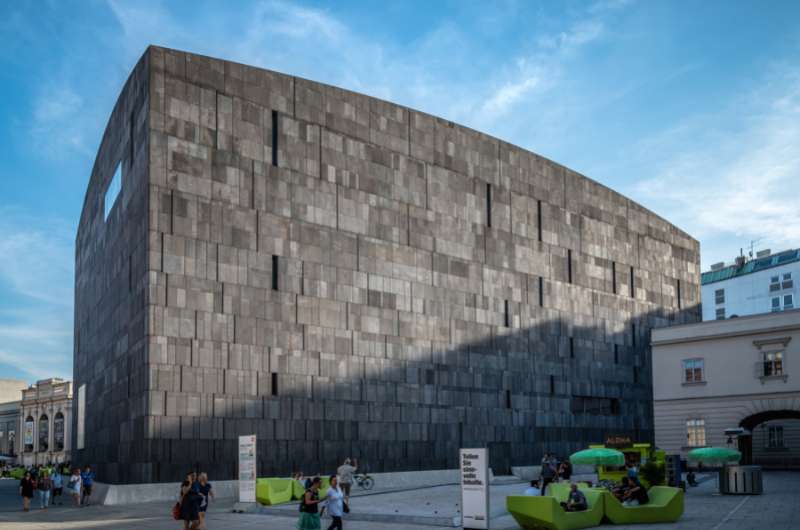
Museum moderner Kunst Stiftung Ludwig Wien aka the modern art museum
Distance from last stop: 0
Time spent here: 1.5 hours
Mumok opening hours & tickets
- Open daily except for Mondays, 10 am–6 pm
- Tickets cost EUR 15 for adults
The mumok (full name: Museum moderner Kunst Stiftung Ludwig Wien) is one of the museums in the Museum Quartier. You can’t miss it—it’s the big, grey, windowless one that screams “I’m a contemporary art museum”.
As such, the offering inside is... not boring. But as far as modern art goes, it has some of the wackiest pieces I’ve ever seen. Just remember: if in doubt, don’t sit on it or throw any garbage into it thinking it’s a garbage can. Or how about a large, blue, stuffed spider?
Closed Jan 8—Jun 6 2024 for floor and wall refurbishment, mumok is now gleaming again. First big post-reno show: “Never Final! The Evolving Museum” (27 Mar 2025–12 Apr 2026).
The interior of the mumok is simple and white in the exhibition rooms and grey and industrial in between.
Exhibits change periodically, so check the website before you visit to see what to expect.
There’s a gift shop and café on site, too.
Alternative museums: The mumok isn’t for everyone. If you know you’d hate it, skip it and try the Austrian Architecture Museum, the Leopold Museum (Austrian modern art), international contemporary art at the Kunsthalle, or the interactive children’s museum called ZOOM. It’s best if you actually have kids to go there, but to each their own.
Day 3, stop 3: Kunsthistorisches Museum Vienna, aka Art History Museum
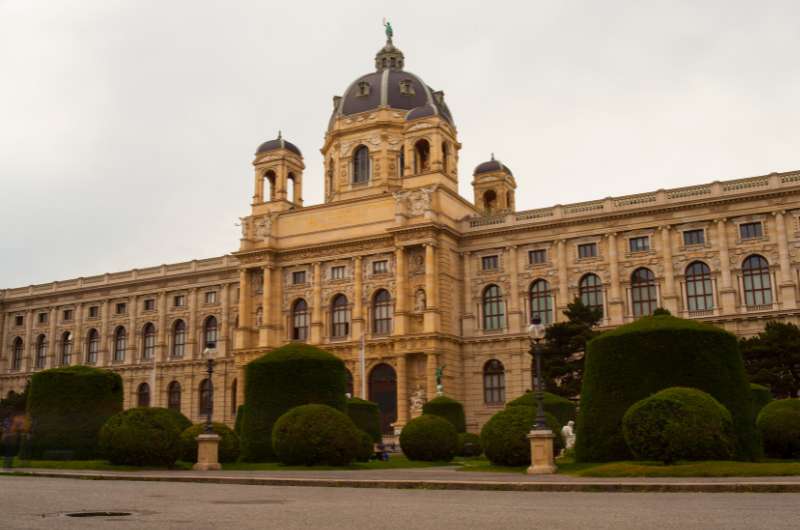
Kunsthistorisches Museum Vienna
Distance from last stop: 200 m (0.1 miles)/2-minute walk
Time spent here: 2–4 hours
Kunsthistorisches Museum opening hours & tickets
- Tuesday to Sunday 10 am–6 pm, Thursdays until 9 pm, closed Mondays
- Tickets cost EUR 23 on-site / EUR 21 online (under-19s free). Book online to save EUR 2 and skip the queue.
To balance out all the newness of the Museum Quartier’s exhibits (or if your eyes still hurt from the mumok), let’s take a step back in time in the Kunsthistorisches Museum, aka Vienna’s Art History Museum.
It’s just a short hop over from the Museum Quartier, but it’s an entirely different world. The world of the Habsburgs (and more)!
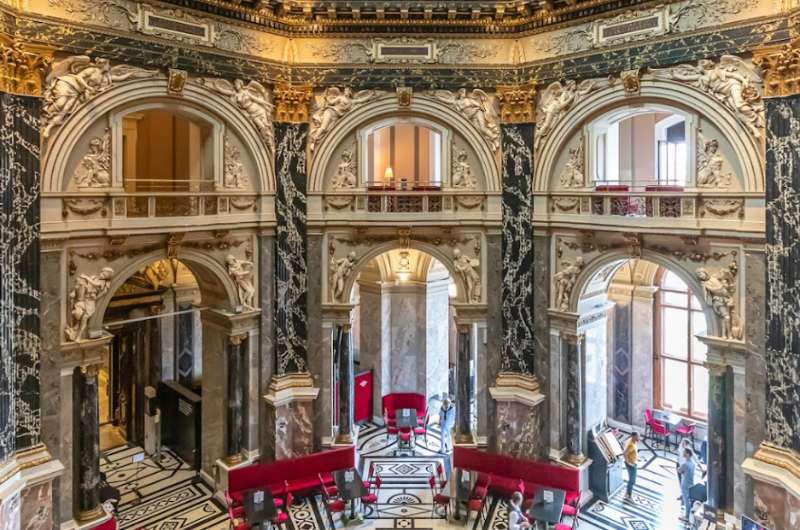
The interiors of the Kunsthistorisches Museum are incredible
I’ve got to say that the interiors of the museum are worth a visit even if you don’t care for old art. It’s very ornate, but not tacky ornate like some palaces. High-level ornate! Don’t forget to look up at the dome in the entrance hall!
Once you browse the collections of each of the Austrian Kaisers, you can step further into history and admire some Egyptian and Greek antiquities on the other floors.
Seeing everything could easily take an art lover 4 hours, so budget your time depending on your interests. If you think you’ll want to soak up all of the Kunsthistorisches Museum’s art, you will need to skip one of the other museums that are planned for today.
You can save some time by seeing a part of the exhibitions on a virtual tour.
Get an audio guide so you know what you are looking at, because, as the museum’s website so smartly says, “You can only see what you know”. There are also audio guides for kids and guided tours available.
If you get your ticket online, you’ll get a time slot during which you must enter.
Day 3, stop 4: Hofburg Palace and Heldenplatz—the epic HQ of the Habsburgs

Hofburg Palace in Vienna, Austria
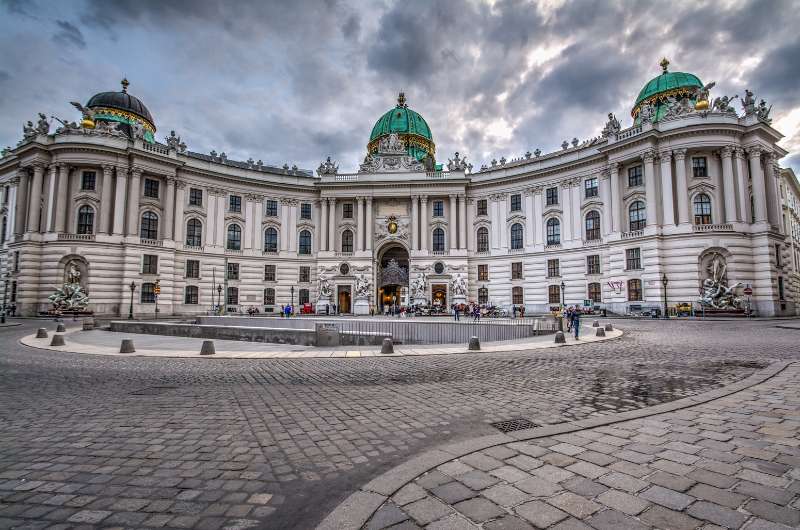
Hofburg Imperial Palace
Distance from last stop: 200 m (0.1 miles)/2-minute walk
Time spent here: 1–2 hours for just the exteriors
Hofburg opening hours & tickets
- Most interiors run 10 am–6 pm; courtyards and parks are open 24/7 and free.
- Spanish Riding School shows Lipizzaner stallions practising to Mozart—times and prices are in my Unusual Vienna guide.
- Type “Hofburg Palace” in Google Maps and follow the crowds.
Moving steadily along in today’s compact sightseeing area—the next spot you’ll want to visit is one of the biggest palace complexes in the world: Hofburg Palace. It might sound surprising since it’s in the middle of Vienna, but the place is vast!
My verdict: A fast lap of Hofburg’s outdoor gems plus the Sisi ticket gave me the imperial fix I wanted and still left time for the Albertina (five minutes away) and a late‑day schnitzel.I love the Hofburg Palace—in small doses. The place is a mini‑city: emperors ruled the Habsburg realm from here for 600 years, and Austria’s president still signs paperwork inside. You could lose a whole day wandering its museums, but on a 3‑day Vienna itinerary, I cherry‑pick the essentials (all free):
- Heldenplatz: Best wide‑angle shot of the palace, plus two equestrian statues that scream “empire!”
- Volksgarten: Rose beds, fountains, and a random Greek temple.
- Burggarten: Leafy shortcut toward the Albertina, with Mozart’s statue en route.
My one paid splurge—the Sisi Ticket Classic
If you crave a peek inside, skip the entire museum buffet and buy the Sisi Ticket Classic (EUR 20 online; 1 h 30 m). It gets you:
-
Sisi Museum—dresses, the Empress’s personal exercise room, plus tabloid‑worthy diaries of Empress Elisabeth “Sisi” (Austria’s 19th-century Diana: adored by the public, miserable at court).
-
Imperial Apartments—the private rooms of Emperor Franz Joseph and his famous wife.
-
Silver Collection—enough gold‑rimmed plates to cater a royal wedding.
That’s the perfect dose of guilt and gossip without tanking the rest of your day in Vienna.
Day 3, stop 5: Albertina
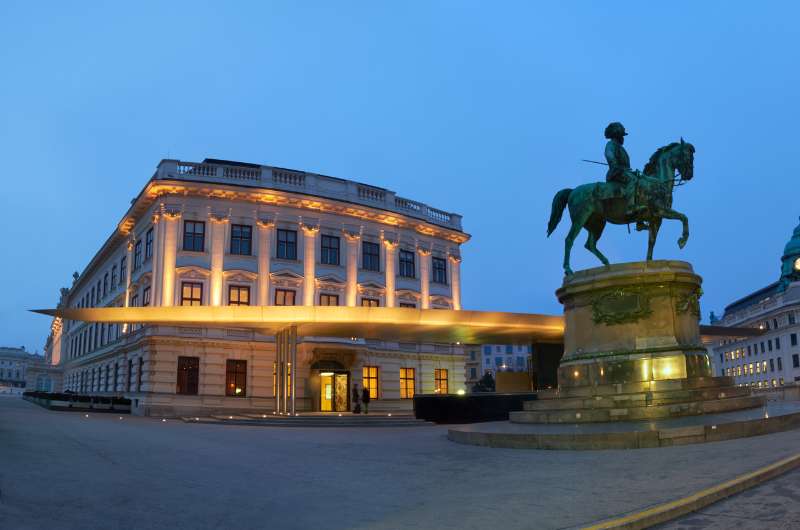
Albertina Museum
Distance from last stop: 700 m (0.5 miles)/8-minute walk
Time spent here: 2 hours
Albertina opening times & tickets
- Open daily 10 am–6 pm, Wednesdays and Fridays until 9 pm
- Tickets cost EUR 19.90 + EUR 5 for smartphone audio guide
The Albertina is famous for housing one of the largest print rooms on Earth, with 65,000 drawings and over a million old master prints. That’s a lot of prints!
They aren’t all always on display because the light would destroy them, so you’ll need to check out the current special exhibitions list to see what you’ll be able to feast your eyes on. You could be lucky and see some Michelangelo!
You can also see more contemporary graphic works, photographs, and architectural drawings. The Albertina’s anchor show remains the “Monet to Picasso – Batliner Collection,” but in 2025 plan on two headline add‑ons: a rare peek at Renaissance master drawings in “Leonardo–Dürer” (runs until early June) and the summer blockbuster “Travels: Artists on the Move” that opens late June. Sister venue Albertina Modern chips in with a first‑ever look at Damien Hirst’s sketchbooks (May–October).
Overall, I found it to be a very interesting mix of art from different genres and time periods.. If you do lean towards everything modern and couldn’t care less for history, check out the nearby Albertina Modern instead.
I spent about 2 hours in Albertina. You may find this useful: The main entrance is on the bastion of the former Vienna city wall. There’s an escalator or an elevator that’ll help you up there.
Time for more Sacher? Hotel Sacher Wien and its Café Sacher (the one you visited on your 1st day of this Vienna itinerary) are just down the block from Albertina in case you are craving some more chocolate delight!
Day 3, stop 6: Prater’s Giant Ferris Wheel
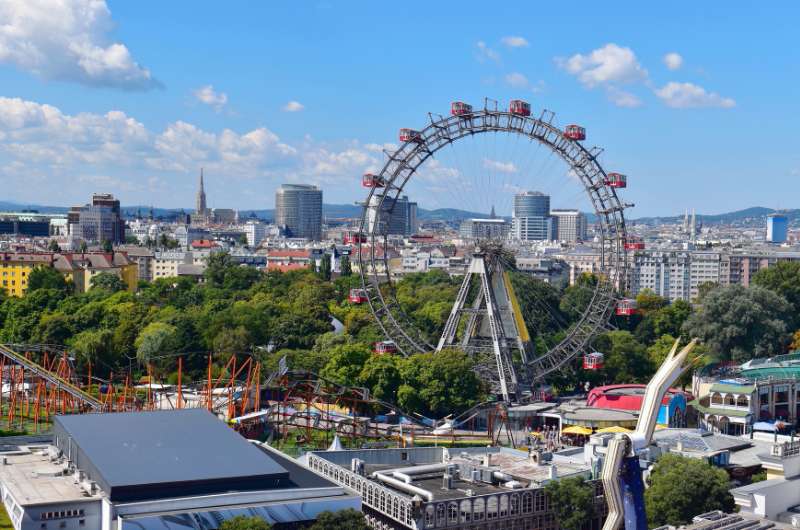
Who has never heard of the famous Prater Amusement Park?
Distance from last stop: 3 km (1.8 miles)
Time spent here: however long you wish
Prater opening times & tickets
- Open (almost) daily year-round, mostly 9 am until midnight
- Tickets for Ferris Wheel cost EUR 14.50, and the park has no entrance fee (pay-per-ride basis).
Your 3rd day in Vienna is almost at its end, so it’s time for some fun! Hop in a taxi and head out to one of Vienna’s most prominent symbols, the Ferris Wheel (“Wiener Riesenrad”).
Located in Prater Amusement Park to the north of Vienna’s city center, The Giant Ferris Wheel. It’s been adorning Vienna’s skyline for over 100 years.
You can either just take a ride in one of the wooden cabins—that takes about 15 minutes—, or, turn it into an extra special experience:
A special experience at Prater
For a kick of adrenaline, hop on Platform 9. You’ll get a harness and then you’ll be strapped onto a simple steel construction with a glass floor! Up you go! Tickets cost EUR 89.
For a culinary experience, buy tickets (in advance) to one of the gourmet wagons and go round and round while you eat! It won’t come cheap though—a dinner for 2 starts at EUR 400.
Before or after your ride, visit the free Panorama Museum at the foot of the Ferris Wheel to learn about the history of the Wheel through audio-visual installations in eight Ferris Wheel cabins.
Of course, the rest of Prater is right there, so if you’re up for it, continue your evening on some fun rides! Each ride is paid for separately, so you can even just wander around and enjoy the atmosphere without paying any kind of entrance fee.
How do I get from Vienna Airport to the city center?
Full disclosure: I usually drive down from Prague—3.5 hours on cruise control, and I’m parked by the Ring. But for those of you arriving on a plane, here’s the intel I dug up:
Forget the over‑hyped CAT “city airport train.” It’s EUR 14 and saves you a whopping… six minutes. I’d hop on the regular S7 suburban train—EUR 4.40, 25 minutes to Wien Mitte, same tracks, less marketing. Actually, I’m lying. I’d probably just book a Bolt for about EUR 35 and judge other drivers’ lane discipline while the Danube fields whiz by.
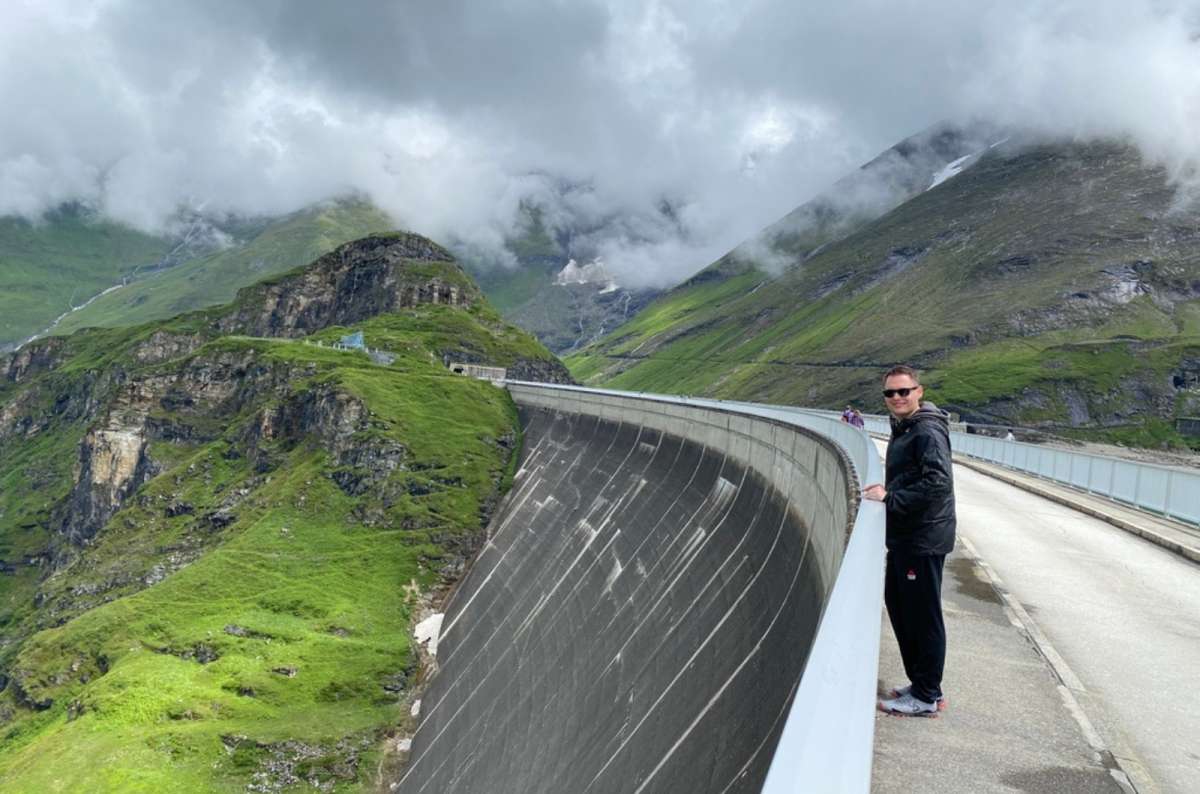
And that’s a wrap for Vienna! I’m off to explore some stunning Alpine views in Austria (here at Kaprun Dam)
FAQ1: Is the Vienna Pass worth it for 3 days?
Usually yes if you plan at least four paid sights per day. The 3-day Vienna Pass costs EUR 139 and covers Schönbrunn Grand Tour, Hofburg Treasury, Belvedere, the Giant Ferris Wheel and hop-on buses—saving ~EUR 40 compared with individual tickets.
FAQ2: What’s the best month to visit Vienna?
Aim for May or September. Both months hit the sweet spot: daytime highs around 20 °C / 68 °F, low rainfall, and far thinner crowds than high‑summer July–August. Hotel rates sit 15–20 % below summer peak, and nearly every sight—from Schönbrunn to the MuseumsQuartier—runs on full operating hours.
FAQ3: How much do 3 days in Vienna cost?
A mid-range visitor spends about EUR 480–550 per person: hotel EUR 260 (2 nights, double-occupancy), food EUR 150, transport EUR 24 (72-hour ticket), attractions EUR 90—including a palace tour, two big museums and the Prater Wheel.
FAQ4: Are Sundays really closed in Vienna?
Yes, the city slips into a 1950s time warp every Sunday: shops shutter, locals vanish, and you suddenly notice church bells exist. My workaround is simple—plan museum marathons and café crawls for Sunday. Stock up on snacks and get most sightseeing done on Saturday.
FAQ5: Is Vienna safe at night around Prater & Gürtel?
Short answer: I’ve walked those areas after midnight with nothing scarier than a misfiring kebab neon. The Prater midway is tourist‑cheesy but well‑lit; main threat is winning a giant plush panda you must then haul home. The Gürtel has its share of dive bars and creative characters—keep your wallet in your front pocket and your beer smarts on, and you’ll be fine. Police presence is solid, and Austria’s crime stats are about as exciting as boiled potatoes.
FAQ6: Do you need to tip in Vienna cafés and restaurants?
Yes, but keep it civilized: add 8–10 %. Hand the cash directly to the waiter when you pay—no leaving coins on the table like you’re feeding pigeons.
FAQ7: How many days should you spend in Vienna?
Three full days let first-timers cover the must-sees (Schönbrunn, Hofburg, St Stephen’s, Belvedere) and still squeeze in a museum day and a Prater evening. You’ll be fine even with 2 days, but I wouldn’t stretch it out to four. With extra time, I’d seriously consider taking a day trip from Vienna.
You might also be interested in reading:
- The Ultimate 10-Day Austria Itinerary
- One Perfect Day in Hallstatt
- What is Austria Known For? 13 Tips and Tricks for Your Vacation
- 9 Unusual Things to Do in Vienna
- 7 Best Cities and Towns to Visit in Austria
Sometimes, all you need to do is take the first step... I've filtered out the best hotels in Vienna for you
Save it for yourself to come back to later, or share with your friends on social media!
This post contains affiliate links. If you make a booking through one of my links, I may earn a small commission—at no additional cost to you. Thank you for your support!




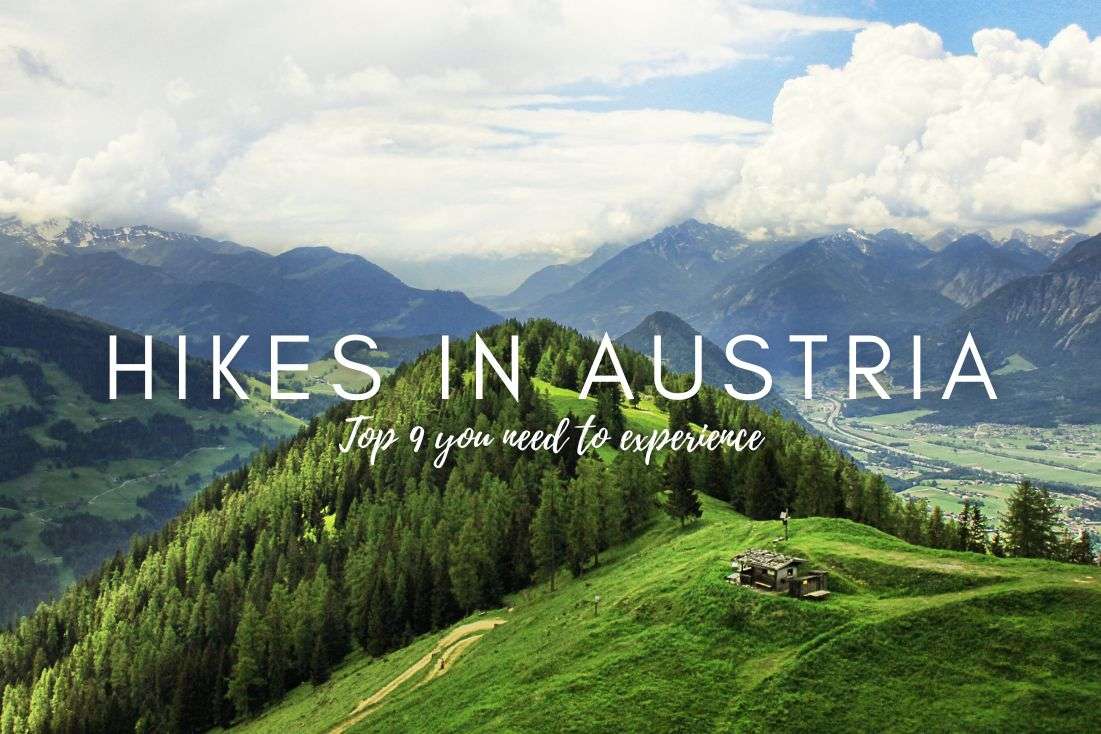
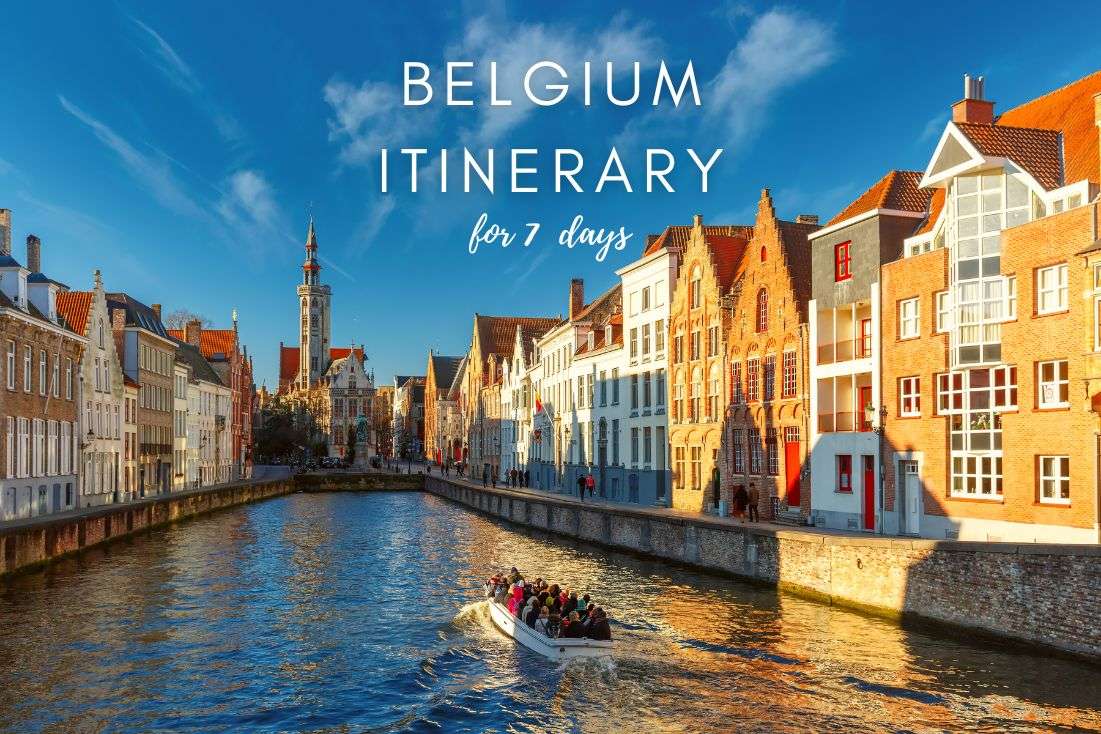
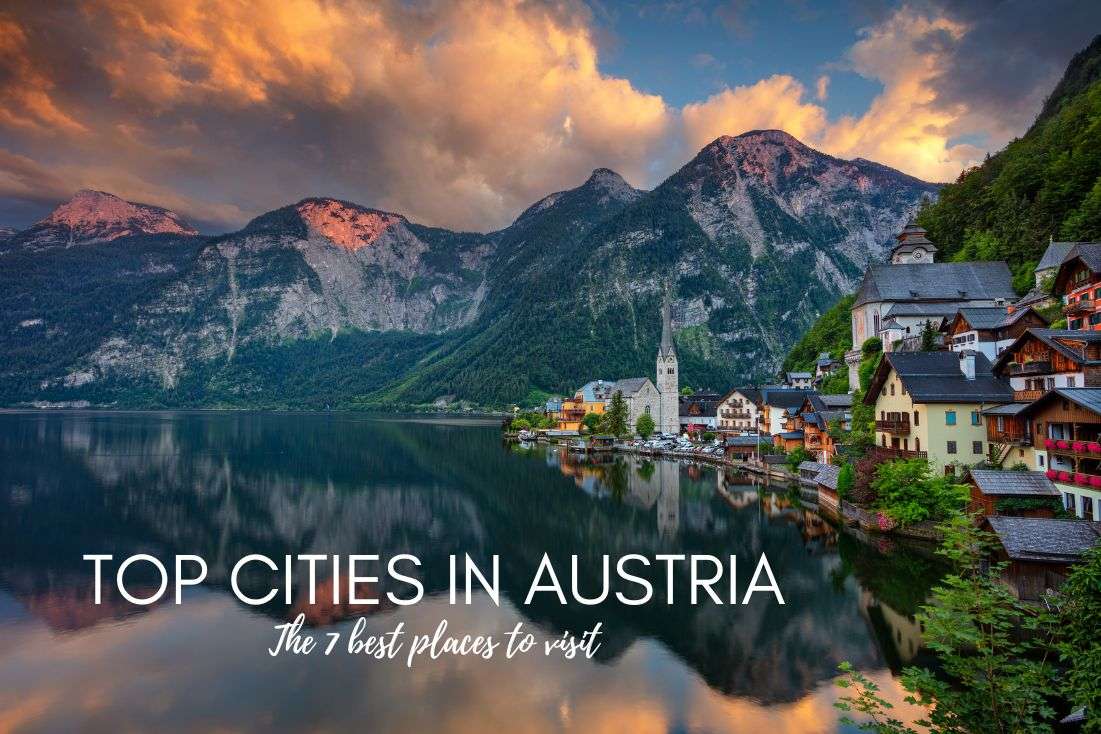



Comments | Thoughts? Give us a shout!